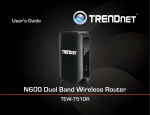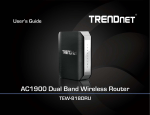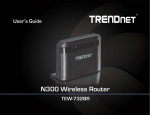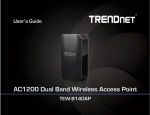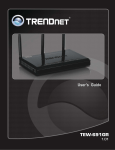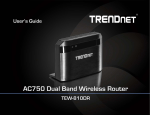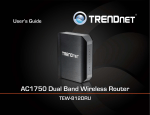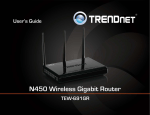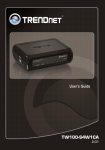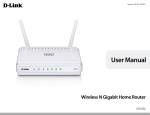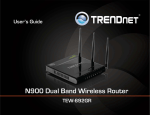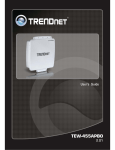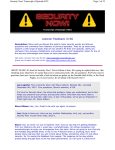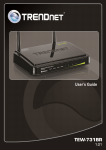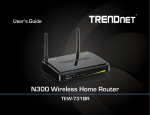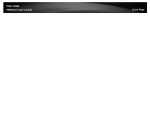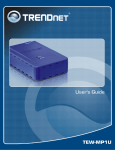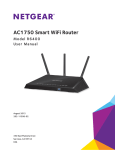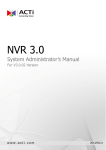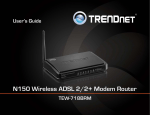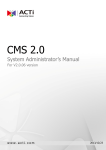Download test 3 - TRENDnet
Transcript
TRENDnet User’s Guide Table of Contents © Copyright 2013 TRENDnet. All Rights Reserved. i TRENDnet User’s Guide Contents Product Overview ...........................................................................4 Package Contents .......................................................................................................... 4 Features ......................................................................................................................... 4 Product Hardware Features........................................................................................... 5 Application Diagram ...................................................................................................... 7 Basic Router Setup ..........................................................................7 Creating a Home Network ............................................................................................. 7 Router Installation ......................................................................................................... 8 Connect additional wired devices to your network..................................................... 10 Wireless Networking and Security ................................................. 11 How to choose the type of security for your wireless network .................................. 11 Secure your wireless network ..................................................................................... 12 Connect wireless devices to your router ..................................................................... 14 Connect wireless devices using WPS ........................................................................... 15 Basic wireless settings ................................................................................................. 16 Guest Zone ................................................................................................................... 18 Steps to improve wireless connectivity ....................................................................... 19 Advanced wireless settings.......................................................................................... 19 Access Control Filters .................................................................... 20 Table of Contents Change your router login password ............................................................................ 22 Change your device name ........................................................................................... 22 Manually configure your Internet connection ............................................................ 23 Clone a MAC address ................................................................................................... 23 IPv6 Internet Connection Settings ............................................................................... 23 Auto Detection ........................................................................................................ 24 Static IPv6 ................................................................................................................ 24 Auto-configuration .................................................................................................. 25 PPPoE ...................................................................................................................... 25 IPv6 in IPv4 Tunnel .................................................................................................. 26 6to4 ......................................................................................................................... 27 6rd ........................................................................................................................... 27 Link-local Only ......................................................................................................... 27 LAN IPv6 Address Settings....................................................................................... 27 Change your router IP address .................................................................................... 28 Set up the DHCP server on your router ....................................................................... 28 Set up DHCP reservation ............................................................................................. 29 Enable/disable UPnP on your router ........................................................................... 30 Allow/deny VPN connections through your router ..................................................... 30 Allow/deny multicast streaming.................................................................................. 30 Enable SPI .................................................................................................................... 31 Access control basics ................................................................................................... 20 Identify your network on the Internet ........................................................................ 31 MAC address filters ................................................................................................. 20 Set your router date and time ..................................................................................... 32 Parental Controls/URL Filters .................................................................................. 20 Create schedules ......................................................................................................... 32 Protocol/IP filters .................................................................................................... 21 Open a device on your network to the Internet.......................................................... 33 Advanced Router Setup ................................................................. 22 Access your router management page ........................................................................ 22 DMZ ......................................................................................................................... 33 Virtual Server .......................................................................................................... 34 © Copyright 2013 TRENDnet. All Rights Reserved. ii TRENDnet User’s Guide Table of Contents Port Forwarding ...................................................................................................... 35 Application Rules ..................................................................................................... 36 Allow remote access to your router management page ............................................. 36 Internet Bandwidth Control......................................................................................... 37 Add static routes to your router .................................................................................. 37 Router Maintenance & Monitoring................................................ 38 Reset your router to factory defaults .......................................................................... 38 Router Default Settings ............................................................................................... 38 Backup and restore your router configuration settings .............................................. 39 Upgrade your router firmware .................................................................................... 39 Restart your router ...................................................................................................... 40 Check connectivity using the router management page ............................................. 40 Check the router system information.......................................................................... 41 View your router log .................................................................................................... 43 Send router logs to your email .................................................................................... 44 Setup a syslog server from router ............................................................................... 45 View your router packet statistics ............................................................................... 45 View your router active sessions ................................................................................. 46 View your routing table ............................................................................................... 46 View devices connected to your router....................................................................... 47 View wireless devices connected to your router......................................................... 47 View your router’s IPv6 network information ............................................................. 47 Router Management Page Structure ............................................. 48 Technical Specifications................................................................. 49 Troubleshooting ............................................................................ 50 Appendix ...................................................................................... 51 © Copyright 2013 TRENDnet. All Rights Reserved. iii TEW-733GR TRENDnet User’s Guide Product Overview Features TEW-733GR TRENDnet’s N300 Wireless Gigabit Router, model TEW-733GR, offers proven high performance 300 Mbps wireless n networking and gigabit wired Ethernet ports. Embedded GREENnet technology reduces power consumption by up to 50%. For your security this router comes preencrypted and features a guest network. Seamlessly stream HD video with this powerful router. Ease of Use Easy Setup Get up and running in minutes with the intuitive guided setup One Touch Connection Securely connect to the router at the touch of the Wi-Fi Protected Setup (WPS) button Package Contents In addition to your router, the package includes: • • • • Multi-Language Quick Installation Guide CD-ROM (User’s Guide) Network cable (1.5 m / 5 ft.) Power adapter (12V DC, 1A) Security Pre-Encrypted For your security the router is pre-encrypted with a unique password Guest Network Create a secure isolated network for guest internet access only Parental Controls Control access to specific websites If any package contents are missing or damaged, please contact the retail store, online retailer, or reseller/distributor from which the product was purchased. © Copyright 2012 TRENDnet. All Rights Reserved. 4 TEW-733GR TRENDnet User’s Guide Performance N300 Wireless Proven 300 Mbps Wireless N Gigabit Ports Gigabit ports extend high performance wired connections Wireless Coverage Extensive wireless coverage with MIMO antenna technology Quality of Service (QoS) Advanced QoS prioritizes video and audio transmissions Compatibility Compatible with older Wireless G devices Energy Savings Embedded GREENnet technology reduces power consumption by up to 50% IPv6 IPv6 network support *Maximum wireless signal rates are referenced from IEEE 802.11 theoretical specifications. Actual data throughput and coverage will vary depending on interference, network traffic, building materials and other conditions. Product Hardware Features Rear View Reset Button WPS button LAN Ports WAN Port Power Port • • • • • • On/Off Power switch Reset Button: Use an item such as a paperclip to push and hold this button for 10 seconds and release to reset your router to its factory defaults. WPS Button: Wi-Fi Protected Setup Button (WPS), press for 3 seconds to activate feature. LAN Ports” Connect Ethernet cables (also called network cables) from your router LAN ports to your wired network devices. WAN Port: Connect an Ethernet cable from your router WAN port to your modem. Power Port: Connect the included power adapter from your router power port and to an available power outlet. On/Off Power Switch: Push the router On/Off power switch to turn your router “On” (Inner position) or “Off” (Outer position). © Copyright 2012 TRENDnet. All Rights Reserved. 5 TEW-733GR TRENDnet User’s Guide Front View • • Internet (Link/Activity) LED: This LED indicator is solid green when your router WAN port is physically connected to the modem Network port (also called network port) successfully with a Network cable. The LED indicator will be blinking green while data is transmitted or received through the WAN port of your router. Power LED: This LED indicator is solid green when your router is powered on. Otherwise if this LED indicator is off, there is no power to your router. WPS button Wireless LED LAN 1-4 LEDs Internet LED Power LED • • • WPS LED: This LED indicator blinks when WPS is active and searching for WPS clients. Wireless (Link/Activity) LED: This LED indicator is blinking green when the wireless is “On” and functioning properly on your router. This LED indicator will be blinking green rapidly while data is transmitted or received by your wireless clients or wireless network devices connected to your router. LAN 1-4 (Link/Activity) LEDs: These LED indicators are solid green when the LAN ports are successfully connected to your wired network devices (which are turned on). These LED indicators will blink green while data is transmitted or received through your router’s LAN ports. © Copyright 2012 TRENDnet. All Rights Reserved. 6 TEW-733GR TRENDnet User’s Guide Application Diagram Basic Router Setup Creating a Home Network What is a network? A network is a group of computers or devices that can communicate with each other. A home network of more than one computer or device also typically includes Internet access, which requires a router. A typical home network may include multiple computers, a media player/server, a printer, a modem, and a router. A large home network may also have a switch, additional routers, access points, and many Internet-capable media devices such as TVs, game consoles, and Internet cameras. The router is installed near the modem typically supplied by your ISP “Internet Service Provider. The router’s WAN port is physically connected to the modem’s network port which connects to the Internet. Wireless signals from the router are broadcasted to wireless clients such as laptops (with wireless capability) thereby providing Internet access throughout your network. • Modem: Connects a computer or router to the Internet or ISP (Internet Service Provider). • Router: Connects multiple devices to the Internet. • Switch: Connect several wired network devices to your home network. Your router has a built-in network switch (the LAN port 1-4). If you have more wired network devices than available Ethernet ports on your router, you will need an additional switch to add more wired connections. How to set up a home network 1. For a network that includes Internet access, you’ll need: • Computers/devices with an Ethernet port (also called network port) or wireless networking capabilities. • A modem and Internet service to your home, provided by your ISP (modem typically supplied by your ISP). • A router to connect multiple devices to the Internet. 2. Make sure that your modem is working properly. Your modem is often provided by your Internet Service Provider (ISP) when you sign up for Internet service. If your modem is not working contact your ISP to verify functionality. 3. Set up your router. See “How to setup your router” below. 4. To connect additional wired computers or wired network devices to your network, see “Connect additional wired devices to your network” on page 10. © Copyright 2012 TRENDnet. All Rights Reserved. 7 TEW-733GR TRENDnet User’s Guide 5. To set up wireless networking on your router, see “Secure your wireless network” on page 12. How to setup your router Refer to the Quick Installation Guide or continue to the next section “Router Installation” on page 8 for more detailed installation instructions. Where to find more help In addition to this User’s Guide, you can find help below: • http://www.trendnet.com/support (documents, downloads, and FAQs are available from this Web page) Router Installation Before you Install Many Internet Service Providers (ISPs) allow your router to connect to the Internet without verifying the information fields listed below. Skip this section for now and if your router cannot connect to the Internet using the standard installation process, come back to this page and contact your ISP to verify required ISP specification fields listed below. 1. Obtain IP Address Automatically (DHCP) Host Name (Optional) Clone Mac Address (Optional) 2. Fixed IP address WAN IP Address: _____. _____._____._____ (e.g. 215.24.24.129) WAN Subnet Mask: _____. _____._____._____ WAN Gateway IP Address: _____. _____._____._____ DNS Server Address 1: _____. _____._____._____ DNS Server Address 2: _____. _____._____._____ 3. PPPoE to obtain IP automatically User Name: _________ Password: ________________ Verify Password: ________________ 4. PPPoE with a fixed IP address User Name: _________ Password: ________________ Verify Password: ________________ IP Address: ____. _____._____._____ (e.g. 215.24.24.129) © Copyright 2012 TRENDnet. All Rights Reserved. 8 TEW-733GR TRENDnet User’s Guide Hardware Installation 1. Verify that you have an Internet connection when connecting your computer directly to your modem. Setup Wizard 1. Open your web browser and the router’s configuration screen will automatically appear. If not type, http://tew-733gr on the address bar of your web browser. 2. Select the language to use on the bottom drop-down list to select your preferred language. Enter the default user name and password and then click Login to continue. Default User Name: admin Default Password: Please refer to the device label or wireless sticker on the unit for more information. Note: For added security your router has a unique login password and wireless settings. 2. Turn off your modem. 3. Disconnect the Network cable from your computer to your modem. 4. Use a Network cable and connect the WAN port (yellow port) on the router to your modem. 5. Use another Network cable and connect your computer to one of the four LAN ports on the router. 6. Plug in the power adapter, connect it to the router’s power port, and then push the On/Off Power Switch to the “On” position (pushed in). 7. Turn on your modem. 8. Verify that the following front panel LED indicators on your router: Power (Solid Green), Status (Blinking Green), LAN 1, 2, 3, or 4 (Solid/Blinking Green for ports for which devices are connected), WAN (Solid/Blinking Green), and WLAN (Blinking Green). 3. Once you are logged in to the router. You will begin the router’s setup wizard. Click Next. © Copyright 2012 TRENDnet. All Rights Reserved. 9 TRENDnet User’s Guide 4. The setup wizard will detect your internet connection. Continue to step 6 if your internet connection type was detected. 5. If the wizard was unable to detect your internet connection type you will be asked to select your internet connection type. Click Next to continue. Please contact your ISP (Internet Service Provider) for additional information of your internet connection type. TEW-733GR Connect additional wired devices to your network You can connect additional computers or other network enabled devices to your network by using Ethernet cables to connect them to one of the available LAN ports labeled 1,2,3,4 on your router. Check the status of the LED indicators (1, 2, 3, or 4) on the front panel of your router to ensure the physical cable connection from your computer or device. 6. Verify your wireless settings and click Exit to complete the wizard. Note: If you encounter issues connecting to your network, there may be a problem with your computer or device network settings. Please ensure that your computer or device network settings (also called TCP/IP settings) are configured to obtain IP address settings automatically (also called dynamic IP address or DHCP) and to Obtain DNS Server address settings automatically. Note: For added security your router comes with preconfigured wireless settings, please refer to the device label or wireless sticker on the unit for more information. © Copyright 2012 TRENDnet. All Rights Reserved. 10 TEW-733GR TRENDnet User’s Guide Wireless Networking and Security How to choose the type of security for your wireless network Setting up wireless security is very important. Leaving your wireless network open and unsecure could expose your entire network and personal files to outsiders. TRENDnet recommends reading through this entire section and setting up wireless security on your new router. There are a few different wireless security types supported in wireless networking each having its own characteristics which may be more suitable for your wireless network taking into consideration compatibility, performance, as well as the security strength along with using older wireless networking hardware (also called legacy hardware). It is strongly recommended to enable wireless security to prevent unwanted users from accessing your network and network resources (personal documents, media, etc.). In general, it is recommended that you choose the security type with the highest strength and performance supported by the wireless computers and devices in your network. Please review the security types to determine which one you should use for your network. Wireless Encryption Types • WEP: Legacy encryption method supported by older 802.11b/g hardware. This is the oldest and least secure type of wireless encryption. It is generally not recommended to use this encryption standard, however if you have old 802.11 b or 802.11g wireless adapters or computers with old embedded wireless cards(wireless clients), you may have to set your router to WEP to allow the old adapters to connect to the router. Note: This encryption standard will limit connection speeds to 54Mbps. • WPA: This encryption is significantly more robust than the WEP technology. Much of the older 802.11g hardware was been upgraded (with firmware/driver upgrades) to support this encryption standard. Total wireless speeds under this encryption type however are limited to 54Mbps. • WPA-Auto: This setting provides the router with the ability to detect wireless devices using either WPA or WPA2 encryption. Your wireless network will automatically change the encryption setting based on the first wireless device connected. For example, if the first wireless client that connects to your wireless network uses WPA encryption your wireless network will use WPA encryption. Only when all wireless clients disconnect to the network and a wireless client with WPA2 encryption connects your wireless network will then change to WPA2 encryption. NOTE: WPA2 encryption supports 802.11n speeds and WPA encryption will limit your connection speeds to 54Mbps • WPA2: This is the most secure wireless encryption available today, similar to WPA encryption but more robust. This encryption standard also supports the highest connection speeds. TRENDnet recommends setting your router to this encryption standard. If you find that one of your wireless network devices does not support WPA2 encryption, then set your router to either WPA or WPA-Auto encryption. Note: Check the specifications of your wireless network adapters and wireless appliances to verify the highest level of encryption supported. Below is brief comparison chart of the wireless security types and the recommended configuration depending on which type you choose for your wireless network. Security Standard Compatible Wireless Standards Highest Performance Under This Setting Encryption Strength Additional Options Recommended Configuration WEP IEEE 802.11a/b/g (802.11n devices will operate at 802.11g to connect using this standard) WPA IEEE 802.11a/b/g (802.11n devices will operate at 802.11g to connect using this standard) IEEE 802.11a/b/g/n Up to 54Mbps Up to 54Mbps Up to 450Mbps* Low Open System or Shared Key, HEX or ASCII, Different key sizes Medium High TKIP or AES, Preshared Key or RADIUS TKIP or AES, Preshared Key or RADIUS TKIP Preshared Key 8-63 characters AES Preshared Key 8-63 characters Open System ASCII 13 characters WPA2 *Dependent on the maximum 802.11n data rate supported by the device (150Mbps, 300Mbps, or 450Mbps) © Copyright 2012 TRENDnet. All Rights Reserved. 11 TEW-733GR TRENDnet User’s Guide Secure your wireless network Wireless > Security Selecting WEP: If selecting WEP (Wired Equivalent Privacy), please review the WEP settings to configure and click Apply to save the changes. After you have determined which security type to use for your wireless network (see “How to choose the security type for your wireless network” on page 11), you can set up wireless security. 1. Log into your router management page (see “Access your router management page” on page 22). 2. Click on Wireless, and click on Security. 3. Click on the Authentication Type drop-down list to select your wireless security type. • WEP: Choose Open System or Shared Key. Note: It is recommended to use Open System because it is known to be more secure than Shared Key. • Mode: Choose HEX or ASCII. Note: It is recommended to use ASCII because of the much larger character set that can be used to create the key. • WEP Key: Choose the key length 64-bit or 128-bit. Note: It is recommended to use 128-bit because it is more secure to use a key that consists of more characters. WEP Key Format HEX ASCII Character set 0-9 & A-F, a-f only Alphanumeric (a,b,C,?,*, /,1,2, etc.) 64-bit key length 10 characters 5 characters 128-bit key length 26 characters 13 characters © Copyright 2012 TRENDnet. All Rights Reserved. 12 TEW-733GR TRENDnet User’s Guide • Key 1-4 o This is where you enter the password or key needed for a computer to connect to the router wirelessly o You can define up to 4 passwords or 4 keys. Only one key can be active at a given time. Most users simply define one key. o Choose a key index 1, 2, 3, or 4 and enter the key. o When connecting to the router, the client must match both the password and the Key number. (e.g. if you have activated Key 2 with a password of 12345, then the client must select: Key 2 (entering Key 1, 3, or 4 will block the ability to connect) and enter password 12345) Selecting WPA, WPA-Auto, or WPA2 (WPA2 recommended): First, from the Authentication Type row, select WPA, WPA-Auto, or WPA2. Then from the PSK/EAP row, select either PSK or EAP • PSK stands for Preshared Key • EAP stands for Extensive Authentication Protocol, also called Remote Authentication Dial-In User Service or RADIUS). Note: EAP requires an external RADIUS server, PSK only requires you to create a passphrase. The following section outlines options when selecting PSK (Preshared Key Protocol), o Select a Cipher Type. When selecting WPA security, it is recommended to use TKIP. o When selecting WPA-Auto security, it is recommended to use AES. o When selecting WPA2 security, it is recommended to use AES. Create your Wireless security Passphrase (password or key): • Passphrase – Enter the passphrase. • This is the password or key that is used to connect your computer to this router wirelessly • Confirmed Passphrase – Re-enter the passphrase. Note: 8-63 alphanumeric characters (a,b,C,?,*, /,1,2, etc.) The following section outlines options when selecting EAP (Extensive Authentication Protocol), EAP (Extensible Authentication Protocol) is also called Remote Authentication Dial-In User Service or RADIUS. Select a Cipher Type o When selecting WPA security, it is recommended to use TKIP. o When selecting WPA-Auto security, it is recommended to use AES. o When selecting WPA2 security, it is recommended to use AES. © Copyright 2012 TRENDnet. All Rights Reserved. 13 TEW-733GR TRENDnet User’s Guide Connect wireless devices to your router A variety of wireless network devices can connect to your wireless network such as: • • • • • • Gaming Consoles Internet enabled TVs Network media players Smart Phones Wireless Laptop computers Wireless IP cameras Each device may have its own software utility for searching and connecting to available wireless networks, therefore, you must refer to the User’s Manual/Guide of your wireless client device to determine how to search and connect to this router’s wireless network. See the “Appendix” on page 51 for general information on connecting to a wireless network. • RADIUS Server 1/2 - Configure the RADIUS server settings. Note: RADIUS Server 2 is optional and can be configured as a backup if there are any issues with RADIUS Server 1. o IP – Enter the IP address of the RADIUS server. (e.g. 192.168.10.250) o Port – Enter the port your RADIUS server is configured to use for RADIUS authentication. Note: It is recommended to use port 1812. o Shared Secret – Enter the shared secret used to authorize your router with your RADIUS server. © Copyright 2012 TRENDnet. All Rights Reserved. 14 TEW-733GR TRENDnet User’s Guide Connect wireless devices using WPS WPS (Wi-Fi Protected Setup) is a feature that makes it easy to connect devices to your wireless network. If your wireless devices support WPS, you can use this feature to easily add wireless devices to your network. PBC (Software/Virtual Push Button) Wireless >WiFi Protected Setup Note: You will not be able to use WPS if you set the SSID Broadcast setting to Disabled. In addition to the hardware push button located physically on your router, the router management page also has push button which is a software or virtual push button you can click to activate WPS on your router. There are two methods the WPS feature can easily connect your wireless devices to your network. 1. Log into your router management page (see “Access your router management page” on page 22). • Push Button Configuration (PBC) method o RECOMMENDED Hardware Push Button method–with an external button located physically on your router and on your client device o WPS Software/Virtual Push Button - located in router management page • PIN (Personal Identification Number) Method - located in router management page 2. Click on Wireless, and click on WPS. 3. To add a wireless device to your network, simply click Connect under Add Wireless Station to begin WPS. Note: Refer to your wireless device documentation for details on the operation of WPS. Recommended Hardware Push Button (PBC) Method To add a wireless device to your network, simply push the WPS button on the wireless device you are connecting(consult client device User’s Guide for length of time), then push and hold the WPS button located on your router for 3 seconds and release it. A Green LED on your router WPS button will flash indicating that the WPS setup process has been activated on your router. (See “Product Hardware Features” on page 5) 4. You will receive an option of Auto and Manual. Select Auto and click Next to continue with WPS. For connecting additional WPS supported devices, repeat this process for each additional device. Note it is recommended that a wireless key (passphrase or password) is created before connecting clients using the PBC method. If no wireless key is defined when connecting via PBC, the router will automatically create an encryption key that is 64 characters long. This 64 character key will then have to be used if one has to connect computers to the router using the traditional connection method. 5. Select PBC option to continue using WPS PBC method and click Next . © Copyright 2012 TRENDnet. All Rights Reserved. 15 TEW-733GR TRENDnet User’s Guide 4. You will receive an option of Auto and Manual. Select Auto and click Next to continue with WPS. Note: You may need to initiate the WPS PIN on your wireless device first when using this method. Refer to your wireless device documentation for details on the operation of WPS. 5. Select PIN option and enter your wireless device’s PIN information. Click Next to continue. 5. You will receive a success message indicate that the wireless device successfully connected using WPS. PIN (Personal Identification Number) Wireless >WiFi Protected Setup If your wireless device has WPS PIN (typically an 8-digit code printed on the wireless device product label or located in the wireless device wireless software utility), you can use this method. Basic wireless settings 1. Log into your router management page (see “Access your router management page” on page 22). Wireless > Basic 2. Click on Wireless, and click on WPS. This section outlines available management options under the Basic Wireless sub tab. 3. To add a wireless device to your network, simply click Connect under Add Wireless Station to begin WPS. 1. Log into your router management page (see “Access your router management page” on page 22). 2. Click on Wireless, and click on Basic. 3. To save changes to this section, click Save Settings when finished. © Copyright 2012 TRENDnet. All Rights Reserved. 16 TRENDnet User’s Guide • Wireless o Enable: Check the box to enable wireless networking on your router. o Disable: Uncheck the box to disable wireless networking o Schedule: Select an applied schedule rule on the drop down list of when the wireless network will be enabled. Select Always to have wireless network always enabled. o New Schedule: Click this button to set a new schedule rule. • Wireless Network Name (SSID): The acronym SSID stands for Service Set Identifier and is the name of your wireless network. It differentiates your wireless network from others around you. By default, the router has a predefined SSID (refer to the wireless sticker or device label). If you choose to change the SSID, change it to a name that you can easily remember. TEW-733GR o 2.4GHz 802.11b only mode: This mode only allows devices to connect to the router using older and slow 802.11b technology (typically not recommended). Note: Please check the specifications on your wireless devices for the highest wireless capability supported first before applying these settings. If you are unsure, it is recommended that you keep the default setting (2.4GHz 802.11b/g/n mixed mode) for the best compatibility. When applying the 802.11 mode setting, please keep in mind the following: • Wireless devices that support 802.11n are backwards compatible and can connect wirelessly at 802.11g or 802.11b. • Connecting at 802.11b or 802.11g will limit the capability of your 802.11n supported wireless devices from obtaining higher performance and data rates. • Allowing 802.11b or 802.11g devices to connect to an 802.11n capable wireless network may degrade the wireless network performance below the higher performance and data rates of 802.11n. • Wireless devices that only support 802.11b or 802.11g will not be able to connect to a wireless network that is set to 802.11n only mode. • Wireless devices that only support 802.11b will not be able to connect to a wireless network that is set to 802.11g only mode. • 802.11 Mode: Select the appropriate mode for your network. o 2.4GHz 802.11b/g/n mixed mode: Select this mode for the best compatibility. This mode allows older 802.11b and 802.11g wireless devices to connect to the router in addition to newer 802.11n devices. o 2.4GHz 802.11b/g mixed mode: This mode only allows devices to connect to the router using older and slow 802.11b or 802.11g technology and it thereby reduces the router’s maximum speed to 54Mbps (typically not recommended). o 2.4GHz 802.11n only mode: This mode only allows newer 802.11n devices to connect to your router. This mode does ensure the highest speed and security for your network, however if you have older 802.11g wireless clients, they will no longer be able to connect to this router. o 2.4GHz 802.11g only mode: This mode only allows devices to connect to the router using older and slow 802.11g technology (typically not recommended). • Auto Channel: In North America, this router can broadcast on 1 of 11 Channels (13 in Europe and other countries). Selecting Auto Channel enables the router to automatically select the best Channel for wireless communication. • Channel: To manually set the channel on which the router will broadcast, uncheck Auto Channel, then click the drop-down list and select the desired Channel for wireless communication. The goal is to select the Channel that is least used by neighboring wireless networks. • Transmission Rate: Set the transmission rate of your wireless network. Please note that it is best that this setting remains on the default setting of Best. © Copyright 2012 TRENDnet. All Rights Reserved. 17 TEW-733GR TRENDnet User’s Guide • 802.11 Mode: Select the appropriate mode for your network. Guest Zone Access > Guest Zone • Channel Width: This setting only applies to wireless devices connecting at 802.11n. Select the appropriate channel width for your wireless network. o 20 MHz: This mode operates using a single 20MHz channel for wireless devices connecting at 802.11n. This setting may provide more stability than Auto 20/40 MHz for connectivity in busy wireless environments where there are several wireless networks in the area. o Auto 20/40 MHz: This mode can automatically switch between using a single 20MHz channel or 40MHz (two 20MHz channels). When 40MHz is active, this mode is capable of providing higher performance only if the wireless devices support the 40MHz channel width. Enabling 20/40MHz typically results in substantial performance increases when connecting to an 802.11n client. Creating an isolated and separate wireless guest network allows wireless clients to connect to your network for Internet access only and keep your local LAN network safe by restricting guest access to your LAN network resources such as shared documents and media files on your computers, network storage, and printers. 1. Log into your router management page (see “Access your router management page” on page 22). 2. Click on Access and click on Guest Zone. • Visibility Status o Visible: Allows wireless devices to search and discover your wireless network name (also called SSID) broadcasted by your router. o Invisible: Turns off the ability for wireless devices to find your network. It is still possible for wireless devices to be configured to connect to your wireless network. Note: Setting this option to Invisible, may cause issues with your wireless adapters. • WMM: Wi-Fi Multimedia is a Quality of Service (QoS) feature which prioritizes audio and video data packets. This feature requires the wireless device to also support WMM. Click Enabled (recommended) or Disabled to turn this feature on or off on your router. 3. Review the Guest Zone settings, click Save Settings to continue. • Enabled: Check the option to enable the Guest Network. Select Always to have guest zone enabled always or select a schedule rule in the pull down menu. • Wireless Network Name (SSID): This acronym stands for Service Set Identifier and is the name of your wireless network. It differentiates your wireless network from others around you. It is recommended to use a different name from your primary wireless network to a name that you can easily identify and differentiate from the primary. You can reference your guests to access this network instead of the primary. • Enable Routing Between Zone: Select this option to allow guests to restrict your guest to only have access to the Internet. • Security Mode: Select the wireless security you would like to apply to the guest zone. © Copyright 2012 TRENDnet. All Rights Reserved. 18 TEW-733GR TRENDnet User’s Guide Steps to improve wireless connectivity Advanced wireless settings Wireless > Advanced There are a number of factors that can impact the range of wireless devices. Follow these tips to help improve your wireless connectivity: 1. Keep the number of obstructions to a minimum. Each obstruction can reduce the range of a wireless device. Position the wireless devices in a manner that will minimize the amount of obstructions between them. a. For the widest coverage area, install your router near the center of your home, and near the ceiling, if possible. b. Avoid placing the router on or near metal objects (such as file cabinets and metal furniture), reflective surfaces (such as glass or mirrors), and masonry walls. c. Any obstruction can weaken the wireless signal (even non-metallic objects), so the fewer obstructions between the router and the wireless device, the better. d. Place the router in a location away from other electronics, motors, and fluorescent lighting. e. Many environmental variables can affect the router’s performance, so if your wireless signal is weak, place the router in several locations and test the signal strength to determine the ideal position. 2. 3. 4. Building materials can have a large impact on your wireless signal. In an indoor environment, try to position the wireless devices so that the signal passes through less dense material such as dry wall. Dense materials like metal, solid wood, glass or even furniture may block or degrade the signal. Antenna orientation can also have a large impact on your wireless signal. Use the wireless adapter’s site survey tool to determine the best antenna orientation for your wireless devices. Interference from devices that produce RF (radio frequency) noise can also impact your signal. Position your wireless devices away from anything that generates RF noise, such as microwaves, radios and baby monitors. These settings are advanced options that can be configured to change advanced wireless broadcast specifications. It is recommended that these settings remain set to their default values unless you are knowledgeable about the effects of changing these values. Changing these settings incorrectly can degrade performance. • Transmit Power: The transmit power of your wireless radio can be adjusted in percentages. Default Value:100% • Beacon Period: A beacon is a management frame used in wireless networks that transmitted periodically to announce the presence and provide information about the router’s wireless network. The interval is the amount time between each beacon transmission. Default Value:100 milliseconds (range: 20-1000) • Preamble Type: Select Short or Long Preamble If possible, upgrade wireless network interfaces (such as wireless cards in computers) from older wireless standards to 802.11n. If a wirelessly networked device uses an older standard, the performance of the entire wireless network may be slower. If you are still experiencing low or no signal consider repositioning the wireless devices or installing additional access points. © Copyright 2012 TRENDnet. All Rights Reserved. 19 TEW-733GR TRENDnet User’s Guide Access Control Filters Access control basics MAC address filters Access > Filter > MAC Filters Every network device has a unique, 12-digit MAC (Media Access Control) address. Using MAC filters, you can allow or deny specific computers and other devices from using this router’s wired or wireless network. Note: MAC filter can be configured to allow access to the listed MAC address and deny all others unlisted or vice versa. The recommended function is to choose to only allow access to the MAC addresses listed and deny all others unlisted because it is easier to determine the MAC addresses of devices in your network then to determine which MAC addresses you do not want to allow access. Add the MAC addresses to the MAC Table first before applying the MAC filter function. 1. Log into your router management page (see “Access your router management page” on page 22). 2. Click on Access, click on Filter, and click on MAC Filters. Click Save Settings to apply rule. Note: Do not configure this setting until you have added the MAC addresses to the MAC Table first. The recommended option is to only Allow access to the MAC addresses listed and deny all others unlisted. • Check box: Check the box to enable rule. • MAC Address – Enter the 12-digit MAC address.(e.g. 00-11-22-AA-BB-CC) • Schedule: Select Always to have rule always on or select a schedule rule. Note: You can check the Dynamic DHCP List for the MAC addresses of the devices on your network, see “Setup the DHCP server on your router” on page 28 or refer to your computer or device documentation to find the MAC address. Parental Controls/URL Filters 3. Review the MAC Filter options. • Turn Off: Disables MAC address filter. • Mac Filter ON and Allow computers/devices with MAC addresses listed below to access the local network (LAN/WLAN), web management, and the Internet. • Mac Filter ON and Deny computers/devices with MAC addresses listed below to access the local network (LAN/WLAN), web management, and the Internet Access > Filter > Domain/URL Blocking You may want to allow or block computers or devices on your network access to specific websites (e.g. www.trendnet.com, etc.), also called domains or URLs (Uniform Resource Locators). You may also enter a keyword (e.g. instead of complete URL to generally allow or block computers or devices access to websites that may contain the keyword in the URL or on the web page. 1. Log into your router management page (see “Access your router management page” on page 22). © Copyright 2012 TRENDnet. All Rights Reserved. 20 TEW-733GR TRENDnet User’s Guide 2. Click on Access, click on Parental Control. Click Save Settings to apply rule. Protocol/IP filters Access > Protocol/IP Filters You may want to block computers or devices on your network access to specific ports (used or required by a specific application) to the Internet. 1. Log into your router management page (see “Access your router management page” on page 22). 2. Click on Access, click on Protocol/IP Filters. Click Add to apply rule. 3. Review the Domain/URL blocking options. • Turn Off: Disables Website Filter address filter. • Allow computers to access only the websites listed below to access the local network (LAN/WLAN), web management, and the Internet. • Deny computers access only the websites listed below. 4. Enter the website you would like to apply. 3. Review the Domain/URL blocking options. • Name: Enter the name of the rule to apply. • Action: Select the action to apply to the rule. • Check box: Check the box to enable rule. • Website URL: Enter the website URL you would like to filter. • Schedule: Select Always to have rule always on or select a schedule rule. o Allow: Allows the listed IP address o Deny: Denies the listed IP address. • Check box: Check the box to enable rule. • IP Address: Enter the IP address of the rule that will reflect on the selected action. • Subnet Mask: Enter the subnet mask of the IP address. © Copyright 2012 TRENDnet. All Rights Reserved. 21 TEW-733GR TRENDnet User’s Guide Advanced Router Setup Access your router management page Note: Your router management page http://192.168.10.1 is accessed through the use of your Internet web browser (e.g. Internet Explorer, Firefox, Chrome, Safari, Opera) and will be referenced frequently in this User’s Guide. 1. Open your web browser (e.g. Internet Explorer, Firefox, Safari, Chrome, or Opera) and go to http://192.168.10.1. Your router will prompt you for a user name and password. 2. Next to Language, click the drop-down list to select your preferred language. Enter the default user name and password and then click Login. Default User Name: admin Default Password: Please refer to the wireless sticker placed on the side of the unit or the device label Change your router login password Main > Password 1. Log into your router management page (see “Access your router management page” on page 22). 2. Click on Main, and click on Password. 3. Under the Administrator section, in the New Password field, enter the new password, and in the Confirm Password field, retype the new password again to confirm. 4. To save changes, click Save Settings. Note: If you change the router login password, you will need to access the router management page using the User Name “admin”. Change your device name Main > Password 1. Log into your router management page (see “Access your router management page” on page 22). 2. Click on Main, and click on Password. 3. In the Gateway Name field, enter the new device name to display on your network to identify the router. Click Save Settings to apply changes. © Copyright 2012 TRENDnet. All Rights Reserved. 22 TEW-733GR TRENDnet User’s Guide Manually configure your Internet connection Main > WAN 1. Log into your router management page (see “Access your router management page” on page 22). 2. Click on Main, and click on WAN. 3. In the Connection Type drop-down list, click the type of Internet connection provided by your Internet Service Provider (ISP). 4. Complete the fields required by your ISP. 5. Complete the optional settings only if required by your ISP. 6. To save changes, click Apply. modem, you should first determine the MAC address of the device or computer and manually enter it into your router using the clone MAC address feature. Note: For many ISPs that provide dynamic IP addresses automatically, typically, the stored MAC address in the modem is reset each time you restart the modem. If you are installing this router for the first time, turn your modem before connecting the router to your modem. To clear your modem stored MAC address, typically the procedure is to disconnect power from the modem for approximately one minute, then reconnect the power. For more details on this procedure, refer to your modem’s User Guide/Manual or contact your ISP. 1. Log into your router management page (see “Access your router management page” on page 22). 2. Click on Main, and click on WAN. 3. Under your Internet connection settings, find the MAC Address section shown below. Note: If you are unsure which Internet connection type you are using, please contact your ISP. Note: If your ISP requires a host name to be specified, you can specify it under Main > LAN & DHCP Server, in the Host Name field. To save changes, click Apply at bottom of the page. Clone a MAC address Main > WAN On any home network, each network device has a unique MAC (Media Access Control) address. Some ISPs register the MAC address of the device (usually a router or a computer) connected directly to the modem. If your computer MAC address is already registered with your ISP and to prevent the re-provisioning and registration process of a new MAC address with your ISP, then you can clone the address (assign the registered MAC address of your previous device to your new router). If you want to use the MAC address from the previous device (computer or old router that directly connected to the 4. Click either Clone MAC Address to clone the MAC address of the computer you are currently using or manually enter the 12-digit MAC address of your old router. 5. To save changes, click Save Settings. IPv6 Internet Connection Settings Network > IPv6 Setting IPv6 (Internet Protocol Version 6) is a new protocol that significantly increases the number of available Internet public IP addresses due to the 128-bit IP address structure versus IPv4 32-bit address structure. In addition, there are several integrated enhancements compared to the most commonly used and well known IPv4 (Internet Protocol Version 4) such as: • Integrated IPsec – Better Security • Integrated Quality of Service (QoS) – Lower latency for real-time applications © Copyright 2012 TRENDnet. All Rights Reserved. 23 TEW-733GR TRENDnet User’s Guide • Higher Efficiency of Routing – Less transmission overhead and smaller routing tables • Enable DHCP-PD: Tick the check box to enable the DHCP Prefix Delegation feature. • Easier configuration of addressing • LAN IPv6 Address: Enter the LAN IPv6 address. Note: In order to use IPv6 Internet connection settings, it is required that your ISP provide you with the IPv6 service. Please contact your ISP for availability and more information about the IPv6 service. • LAN IPv6 Link-local Address: This field displays the LAN IPv6 link-local address. 1. Log into your router management page (see “Access your router management page” on page 22). • Enable automatic DHCP-PD in LAN: Tick the check box to enable automatic DHCP-PD in LAN. 2. Click on Main, and click on IPv6. 3. Review the IPv6 Internet Connection settings and select your IPv6 type under My IPv6 Connection section. Click Save Settings to continue. • Address Auto-configuration Settings • Enable automatic IPv6 address assignment: Tick the check box to enable automatic IPv6 address assignment. • Auto-configuration Type: The available IPv6 auto configuration types are SLAAC+RDNSS, SLAAC+Stateless DHCP, and Stateful DHCPv6. • Router Advertisement Lifetime: Displays the router advertisement lifetime in minutes. This field appears when SLAAC+RDNSS or SLAAC+Stateless DHCP is selected. • IPv6 Address Range (Start): Enter the start IPv6 address in the range. This field is only available when Stateful DHCPv6 is selected. • IPv6 Address Range (End): Enter the end IPv6 address in the range. This field is only available when Stateful DHCPv6 is selected. • IPv6 Address Lifetime: Displays the IPv6 address lifetime in minute. This field appears when Stateful DHCPv6 is selected. Static IPv6 Auto Detection IPv6 DNS Settings • Obtain IPv6 DNS Servers automatically: Allows the router to automatically obtain IPv6 DNS server IP addresses. WAN IPv6 Address Settings • Use Link-local Address: Tick the check box to use the link-local address. Deselect this to enter WAN IP information below in this section. • IPv6 Address: Enter the IPv6 address. • Use the following IPv6 DNS Servers: Manually enters the IPv6 DNS server IP addresses. • Subnet Prefix Length: Enter the subnet prefix length. • Primary DNS Server: Enter the primary IPv6 DNS server address. This field is only available when Use the following IPv6 DNS Servers is selected. • Primary DNS Server: Enter the primary IPv6 DNS server address. • Secondary DNS Server: Enter the secondary IPv6 DNS server address. This field is only available when Use the following IPv6 DNS Servers is selected. LAN IPv6 Address Settings • Default Gateway: Enter the default gateway IPv6 address. • Secondary DNS Server: Enter the secondary IPv6 DNS server address. • LAN IPv6 Address Settings • LAN IPv6 Address: Enter the LAN IPv6 address. © Copyright 2012 TRENDnet. All Rights Reserved. 24 TEW-733GR TRENDnet User’s Guide • LAN IPv6 Link-local Address: This field displays the LAN IPv6 link-local address. • Address Auto-configuration Settings • Enable automatic IPv6 address assignment: Tick the check box to enable automatic IPv6 address assignment. • Auto-configuration Type: The available IPv6 auto configuration types are SLAAC+RDNSS, SLAAC+Stateless DHCP, and Stateful DHCPv6. • Router Advertisement Lifetime: Enter the router advertisement lifetime in minutes. This field is only available when SLAAC+RDNSS or SLAAC+Stateless DHCP is selected. • IPv6 Address Range (Start): Enter the start IPv6 address in the range. This field is only available when Stateful DHCPv6 is selected. • IPv6 Address Range (End): Enter the end IPv6 address in the range. This field is only available when Stateful DHCPv6 is selected. • IPv6 Address Lifetime: Displays the IPv6 address lifetime in minute. This field is only available when Stateful DHCPv6 is selected. Auto-configuration IPv6 DNS Settings • Obtain IPv6 DNS Servers automatically: Allows the router to automatically obtain IPv6 DNS server IP addresses. • Use the following IPv6 DNS Servers: Manually enters the IPv6 DNS server IP addresses. • Primary DNS Server: Enter the primary IPv6 DNS server address. This field is only available when Use the following IPv6 DNS Servers is selected. • Secondary DNS Server: Enter the secondary IPv6 DNS server address. This field is only available when Use the following IPv6 DNS Servers is selected. LAN IPv6 Address Settings • Enable DHCP-PD: Tick the check box to enable the DHCP Prefix Delegation feature. • LAN IPv6 Address: Enter the LAN IPv6 address. • Enable automatic IPv6 address assignment: Tick the check box to enable automatic IPv6 address assignment. • Enable automatic DHCP-PD in LAN: Tick the check box to enable automatic DHCP-PD in LAN. • Auto-configuration Type: The available IPv6 auto configuration types are SLAAC+RDNSS, SLAAC+Stateless DHCP, and Stateful DHCPv6. • Router Advertisement Lifetime: Displays the router advertisement lifetime in minutes. This field appears when SLAAC+RDNSS or SLAAC+Stateless DHCP is selected. • IPv6 Address Range (Start): Enter the start IPv6 address in the range. This field is only available when Stateful DHCPv6 is selected. • IPv6 Address Range (End): Enter the end IPv6 address in the range. This field is only available when Stateful DHCPv6 is selected. • IPv6 Address Lifetime: Displays the IPv6 address lifetime in minute. This field appears when Stateful DHCPv6 is selected. PPPoE PPPOE Internet Connection Type • PPPoE Session: Select the PPPoE session. To share this connection with IPv4, click the Share with IPv4 radio button. To create a new connection, click the Create a new session radio button. • Address Mode: Select the PPPoE IP address is dynamic or static. • IP Address: Enter the static IPv6 address. This field is available when Static IP is selected. • Username: Enter the IPv6 PPPOE username. This field is available when Create a new session is selected. • Password: Enter the IPv6 PPPOE password. This field is available when Create a new session is selected. • Verify Password: Re-type the IPv6 PPPOE password. This field is available when Create a new session is selected. • LAN IPv6 Link-local Address: This field displays the LAN IPv6 link-local address. • Service Name: Enter the service name. This is optional. This field is available when Create a new session is selected. • Address Auto-configuration Settings • Reconnect Mode: Select the reconnect mode as Always on, or Manual. • MTU: Enter the Maximum Transmission Unit (MTU) value. © Copyright 2012 TRENDnet. All Rights Reserved. 25 TEW-733GR TRENDnet User’s Guide IPv6 DNS Settings • Obtain IPv6 DNS Servers automatically: Allows the router to automatically obtain IPv6 DNS server IP addresses. • Use the following IPv6 DNS Servers: Manually enters the IPv6 DNS server IP addresses. • Primary DNS Server: Enter the primary IPv6 DNS server address. This field is only available when Use the following IPv6 DNS Servers is selected. • Secondary DNS Server: Enter the secondary IPv6 DNS server address. This field is only available when Use the following IPv6 DNS Servers is selected. LAN IPv6 Address Settings • Enable DHCP-PD: Tick the check box to enable the DHCP Prefix Delegation feature. • LAN IPv6 Address: Enter the LAN IPv6 address. • LAN IPv6 Link-local Address: This field displays the LAN IPv6 link-local address. Address Auto-configuration Settings • Enable automatic IPv6 address assignment: Tick the check box to enable automatic IPv6 address assignment. • Enable automatic DHCP-PD in LAN: Tick the check box to enable automatic DHCP-PD in LAN. • Auto-configuration Type: The available IPv6 auto configuration types are SLAAC+RDNSS, SLAAC+Stateless DHCP, and Stateful DHCPv6. • Router Advertisement Lifetime: Displays the router advertisement lifetime in minutes. This field appears when SLAAC+RDNSS or SLAAC+Stateless DHCP is selected. • IPv6 Address Range (Start): Enter the start IPv6 address in the range. This field is only available when Stateful DHCPv6 is selected. • IPv6 Address Range (End): Enter the end IPv6 address in the range. This field is only available when Stateful DHCPv6 is selected. • IPv6 Address Lifetime: Displays the IPv6 address lifetime in minute. This field appears when Stateful DHCPv6 is selected. IPv6 in IPv4 Tunnel IPv6 in IPv4 Tunnel Settings • Remote IPv4 Address: Enter the remote IPv4 address. • Remote IPv6 Address: Enter the remote IPv6 address. • Local IPv4 Address: Enter the local IPv4 address. • Local IPv6 Address: Enter the local IPv6 address. • Subnet Prefix Length: Enter the subnet prefix length value. IPv6 DNS Settings • Obtain IPv6 DNS Servers automatically: Allows the router to automatically obtain IPv6 DNS server IP addresses. • Use the following IPv6 DNS Servers: Manually enters the IPv6 DNS server IP addresses. • Primary DNS Server: Enter the primary IPv6 DNS server address. This field is only available when Use the following IPv6 DNS Servers is selected. • Secondary DNS Server: Enter the secondary IPv6 DNS server address. This field is only available when Use the following IPv6 DNS Servers is selected. LAN IPv6 Address Settings • Enable DHCP-PD: Tick the check box to enable the DHCP Prefix Delegation feature. • LAN IPv6 Address: Enter the LAN IPv6 address. • LAN IPv6 Link-local Address: This field displays the LAN IPv6 link-local address. • Address Auto-configuration Settings • Enable automatic IPv6 address assignment: Tick the check box to enable automatic IPv6 address assignment. • Enable automatic DHCP-PD in LAN: Tick the check box to enable automatic DHCP-PD in LAN. • Auto-configuration Type: The available IPv6 auto configuration types are SLAAC+RDNSS, SLAAC+Stateless DHCP, and Stateful DHCPv6. • Router Advertisement Lifetime: Displays the router advertisement lifetime in minutes. This field appears when SLAAC+RDNSS or SLAAC+Stateless DHCP is selected. • IPv6 Address Range (Start): Enter the start IPv6 address in the range. This field is only available when Stateful DHCPv6 is selected. © Copyright 2012 TRENDnet. All Rights Reserved. 26 TEW-733GR TRENDnet User’s Guide • IPv6 Address Range (End): Enter the end IPv6 address in the range. This field is only available when Stateful DHCPv6 is selected. • 6rd Configuration: Select the 6rd configuration option. Options to choose from are 6rd DHCPv4 option and Manual Configuration. • IPv6 Address Lifetime: Displays the IPv6 address lifetime in minute. This field appears when Stateful DHCPv6 is selected. • 6rd IPv6 Prefix: Enter the 6rd IPv6 address and prefix value. 6to4 WAN IPv6 Address Settings • 6to4 Address: Displays the 6 to 4 IP address. • 6to4 Relay: Enter the 6to4 relay address. • Primary DNS Server: Enter the primary IPv6 DNS server address. • Secondary DNS Server: Enter the secondary IPv6 DNS server address. LAN IPv6 Address Settings • LAN IPv6 Address: Enter the LAN IPv6 address. • LAN IPv6 Link-local Address: This field displays the LAN IPv6 link-local address. Address Auto-configuration Settings • Enable automatic IPv6 address assignment: Tick the check box to enable automatic IPv6 address assignment. • Auto-configuration Type: The available IPv6 auto configuration types are SLAAC+RDNSS, SLAAC+Stateless DHCP, and Stateful DHCPv6. • Router Advertisement Lifetime: Displays the router advertisement lifetime in minutes. This field appears when SLAAC+RDNSS or SLAAC+Stateless DHCP is selected. • IPv6 Address Range (Start): Enter the start IPv6 address in the range. This field is only available when Stateful DHCPv6 is selected. • IPv6 Address Range (End): Enter the end IPv6 address in the range. This field is only available when Stateful DHCPv6 is selected. • IPv6 Address Lifetime: Displays the IPv6 address lifetime in minute. This field appears when Stateful DHCPv6 is selected. • IPv4 Address Mask Length: Enter the IPv4 mask length. • Assigned IPv6 Prefix: Displays the IPv6 prefix. • 6rd Border Relay IPv4 Address: Enter the 6rd border relay IPv4 address. • Primary DNS Server: Enter the primary IPv6 DNS server address. • Secondary DNS Server: Enter the secondary IPv6 DNS server address. LAN IPv6 Address Settings • LAN IPv6 Address: This field displays the LAN IPv6 address. • LAN IPv6 Link-local Address: This field displays the LAN IPv6 link-local address. • Address Auto-configuration Settings • Enable automatic IPv6 address assignment: Tick the check box to enable automatic IPv6 address assignment. • Auto-configuration Type: The available IPv6 auto configuration types are SLAAC+RDNSS, SLAAC+Stateless DHCP, and Stateful DHCPv6. • Router Advertisement Lifetime: Displays the router advertisement lifetime in minutes. This field appears when SLAAC+RDNSS or SLAAC+Stateless DHCP is selected. • IPv6 Address Range (Start): Enter the start IPv6 address in the range. This field is only available when Stateful DHCPv6 is selected. • IPv6 Address Range (End): Enter the end IPv6 address in the range. This field is only available when Stateful DHCPv6 is selected. • IPv6 Address Lifetime: Displays the IPv6 address lifetime in minute. This field appears when Stateful DHCPv6 is selected. Link-local Only LAN IPv6 Address Settings • LAN IPv6 Link-local Address: This field displays the LAN IPv6 link-local address. 6rd WAN IPv6 Address Settings • Enable Hub and Spoke Mode: Tick the check box to enable the hub and spoke mode. © Copyright 2012 TRENDnet. All Rights Reserved. 27 TEW-733GR TRENDnet User’s Guide Change your router IP address Main > LAN & DHCP Server In most cases, you do not need to change your router IP address settings. Typically, the router IP address settings only needs to be changed, if you plan to use another router in your network with the same IP address settings, if you are connecting your router to an existing network that is already using the IP address settings your router is using, or if you are experiencing problems establishing VPN connections to your office network through your router. Note: If you are not encountering any issues or are not faced with one of the cases described above or similar, it is recommended to keep your router IP address settings as default. Default Router IP Address: 192.168.10.1 Default Router Network: 192.168.10.0 / 255.255.255.0 (e.g. 255.255.255.0) • Host Name: Enter the host name you of your router • Local Domain Name:Enter the domain name to assign to the router • DNS Relay: Select this option to transfer the DNS server information from your ISP to your computer. If selected, your computer uses the router for a DNS server. Note: The DHCP address range will change automatically to your new router IP address settings so you do not have to change the DHCP address range manually to match your new router IP address settings. 4. To save changes, click Save Settings. Note: You will need to access your router management page using your new router IP address to access the router management page. (e.g. Instead of using the default http://192.168.10.1 using your new router IP address will use the following format using your new router IP address http://(new.router.ipaddress.here) to access your router management page. 1. Log into your router management page (see “Access your router management page” on page 22). Set up the DHCP server on your router 2. Click on Main, and click on LAN to enter the LAN setting secion. Main > LAN & DHCP Server 3. Under Router Settings, enter the router IP address you would like to assign. . Your router can be used as a DHCP (Dynamic Host Configuration Protocol) server to automatically assign an IP address to each computer or device on your network. The DHCP server is enabled by default on your router. If you already have a DHCP server on your network, or if you do not want to use your router as a DHCP server, you can disable this setting. It is recommended to leave this setting enabled. 1. Log into your router management page (see “Access your router management page” on page 22). 2. Click on Main, and click on LAN. 3. Review the DHCP Server settings. • IP Address: Enter the new router IP address. (e.g. 192.168.200.1) • Subnet Mask: Enter the new router subnet mask. © Copyright 2012 TRENDnet. All Rights Reserved. 28 TEW-733GR TRENDnet User’s Guide Set up DHCP reservation Main > LAN DHCP (Dynamic Host Configuration Protocol) reservation (also called Static DHCP) allows your router to assign a fixed IP address from the DHCP server IP address range to a specific device on your network. Assigning a fixed IP address can allow you to easily keep track of the IP addresses used on your network by your computers or devices for future reference or configuration such as virtual server (also called port forwarding, see “Virtual Server” on page 34) or special applications (also called port triggering, see “Special Applications” on page 36). • DHCP Server: Enable or Disable the DHCP server. • DHCP IP Address Range: Enter the start and end for the DHCP server range. Note: The Start IP and End IP specify the range of IP addresses to automatically asign to computers or devices on your network. • Lease Time: Enter the DHCP lease time in minutes. Note: The DHCP lease time is the amount of time a computer or device can keep an IP address assigned by the DHCP server. When the lease time expires, the computer or device will renew the IP address lease with the DHCP server, otherwise, if there is no attempt to renew the lease, the DHCP server will reallocate the IP address to be assigned to another computer or device. 4. To save changes, click Save Settings. 1. Log into your router management page (see “Access your router management page” on page 22). 2. Click on Main, and click on LAN & DHCP Server. 3. Review the DHCP reservation settings. Dynamic DHCP List – You can view the list of active lease entries for computers or devices that have been assigned IP addresses automatically from the DHCP server on your router. • • • • Check box: Check the box to enable rule. Name: Enter a name for the reservation. Static DHCP: Enable or Disable the DHCP reservation feature. IP Address: Enter the IP address to assign to the reservation. (e.g. 192.168.10.101) Note: You cannot assign IP addresses outside of the DHCP range. The IP address is required to be within the DHCP IP address range (Start IP & End IP). • MAC Address: Enter the MAC (Media Access Control) address of the computer or network device to assign to the reservation. (e.g. 00:11:22:AA:BB:CC) or click © Copyright 2012 TRENDnet. All Rights Reserved. 29 TEW-733GR TRENDnet User’s Guide Clone Your PC’s MAC Address to automatically copy your computer’s MAC address. • Add/Update: Saves the reservation. Static DHCP List – You can view the list of reservations for computers or devices that have been created in this list. Allow/deny VPN connections through your router Management > Remote Management A Virtual Private Network (VPN) is a network that uses a public network, such as the Internet, to provide secure communications between a remote computer or network and another network. Some offices often provide VPN access to their networks to enable employees to work from their remote office/home office, or while traveling. If your office or place of work has allowed and authorized access for you to access their network through VPN, the default VPN settings in your router have been configured to pass through the most common types of VPN protocols, which typically do not require any additional configuration changes. Enable/disable UPnP on your router Management > Remote Management UPnP (Universal Plug and Play) allows devices connected to a network to discover each other and automatically open the connections or services for specific applications (e.g. instant messenger, online gaming applications, etc.) UPnP is enabled on your router by default to allow specific applications required by your computers or devices to allow connections through your router as they are needed. 1. Log into your router management page (see “Access your router management page” on page 22). 2. Click on Access, and click on Firewall & DMZ. 1. Log into your router management page (see “Access your router management page” on page 22). 2. Click on Access, and click on Advance Network. 3. Next to PPTP, L2TP, or IPsec (depending the VPN protocol your corporation requires) click Enabled or Disabled to turn the VPN pass through feature on or off on your router. Note: It is recommended to leave these settings enabled. 3. Next to UPnP, click Enabled or Disabled to turn the feature on or off on your router. Note: It is recommended to leave this setting enabled, otherwise, you may encounter issues with applications that utilize UPnP in order allow the required communication between your computers or devices and the Internet. 4. To save changes, click Save Settings. 4. To save changes, click Apply. Allow/deny multicast streaming Management > Remote Management In some cases, applications require multicast communication (also called IP multicast which is the delivery of information to a specific group of computers or devices in a single transmission) typically used in media streaming applications. Multicast streaming © Copyright 2012 TRENDnet. All Rights Reserved. 30 TEW-733GR TRENDnet User’s Guide is enabled by default on your router to allow applications that require multicast communication through your router which typically does not require additional configuration changes. 1. Log into your router management page (see “Access your router management page” on page 22). 2. Click on Access, and click on Advanced Network. View the options and click Save Setting to apply changes. Identify your network on the Internet Main > Dynamic DNS Since most ISPs constantly change your home IP address, providing access to devices on your home or small office Local Area Network (such as IP Cameras) from the Internet requires setting up a Dynamic DNS service and entering the parameters into this management area. Dynamic DNS services allow your router to confirm its location to the given Dynamic DNS service, thereby providing the Dynamic DNS service with the ability to provide a virtual fixed IP address for your network. This means that even though your ISP is always changing your IP address, the Dynamic DNS service will be able to identify your network using a fixed address—one that can be used to view home IP Camera and other devices on your local area network. Note: First, you will need to sign up for one of the DDNS service providers listed in the Server Address drop-down list. • Enable IPv4 Multicast Streams: Click box to enable the IPv4 multicast streams feature. This feature will allow multicast traffic to pass through the router from the Internet (IPv4). • Wireless Enhanced Mode: Click box to enable wireless enhanced mode. 1. Sign up for one of the DDNS available service providers list under Server Address. (e.g. dyndns.com, no-ip.com, etc.) 2. Log into your router management page (see “Access your router management page” on page 22). 3. Click on Main and click on Dynamic DNS. View the options and click Save Setting to apply changes. Enable SPI Access> Firewall & DMZ Stateful Packet Inspection (SPI, is known as dynamic packet filtering, helps to prevent cyber-attacks. It validates that the traffic passing through the session conforms to the protocol. 1. Log into your router management page (see “Access your router management page” on page 22). 2. Click on Access, and click on Firewall & DMZ. Click box next to Enable SPI. 4. Next to DDNS, click Enabled. 5. In the Server Address drop-down list, select the provider you selected, and enter your information in the fields. © Copyright 2012 TRENDnet. All Rights Reserved. 31 TEW-733GR TRENDnet User’s Guide • Host Name: Personal URL provided to you by your Dynamic DNS service provider (e.g. www.trendnet.dyndns.biz) • User Name: The user name needed to log in to your Dynamic DNS service account • Password: This is the password to gain access to Dynamic DNS service (NOT your router or wireless network password) for which you have signed up to. • Timeout: Enter the time duration of the Dynamic DNS feature. • Status: Display the current status of the router’s Dynamic DNS Set your router date and time 3. Next to Time Zone, click the drop-down list to select your Time Zone. Click Save Settings to apply changes. 4. Check the Enable Daylight Saving box to enable daylight savings options. You will then need to configure the daylight savings start and end date/time. 5. Select which option you would like to apply for time settings. • Automatic: Click the box to enter the NTP server to use. OR • Manual: Manually enter the date and time settings you would like to apply to the router. Main > Time 1. Log into your router management page (see “Access your router management page” on page 22). 2. Click on Main, and click on Time. Create schedules Advanced > Schedule For additional security control, your router allows you to create schedules to specify a time period when a feature on your router should be activated and deactivated. Before you use the scheduling feature on your router, ensure that your router system time is configured correctly. 1. Log into your router management page (see “Access your router management page” on page 22). 2. Click on Tools and click on Schedule. 3. Review the Schedule settings. Click Add to save settings. © Copyright 2012 TRENDnet. All Rights Reserved. 32 TEW-733GR TRENDnet User’s Guide it is a very insecure technology and will open local area network to greater threats from Internet attacks. It is strongly recommended to use Virtual Server (also called port forwarding, see “Virtual Server” on page 34) to allow access to your computers or network devices from the Internet. 1. Make the computer or network device (for which you are establishing a DMZ link) has a static IP address (or you can use the DHCP reservation feature to ensure the device has a fixed IP address) (see “Set up DHCP reservation” on page 29). A. Signing up for a Dynamic DNS service (outlined in the DDNS section) will provide identification of the router’s network from the Internet. 2. Log into your router management page (see “Access your router management page” on page 22). 3. Click on Access, and click on Firewall & DMZ. • Name: Enter the name for the time and date schedule. • Days(s): Click the All Week radio button to use all the weekdays for this schedule. Click the Select Day(s) radio button to use only the selected days in the week. • Select Day(s): When the Select Day(s) radio button is selected, tick the check box to select which day of the week to be used. • All Day – 24 hrs: Select this option use all the hours in a day. • Time Format: Select the time format. Options to choose from are 12-hour and 24-hour. • Start Time: Enter the starting time of a day when the schedule to begin. • End Time: Enter the ending time of a day when the schedule will end. Open a device on your network to the Internet This router can provide access to devices on your local area network to the Internet using the Virtual Server, Special Application, method (DMZ NOT recommended). DMZ 4. Next to DMZ Enable, click Enabled. Access > DMZ 5. Next to DMZ Host IP, enter the IP address you assigned to the computer or network device to expose to the Internet. You may want to expose a specific computer or device on your network to the Internet to allow anyone to access it. Your router includes the DMZ (Demilitarized Zone) feature that makes all the ports and services available on the WAN/Internet side of the router and forwards them to a single IP address (computer or network device) on your network. The DMZ feature is an easy way of allowing access from the Internet however, 6. To save changes, click Save Settings. © Copyright 2012 TRENDnet. All Rights Reserved. 33 TEW-733GR TRENDnet User’s Guide Virtual Server Access > Virtual Server Note: You should assign a static IP address to the device or use DHCP reservation to ensure the IP address of the device does not change. Virtual Server (also called port forwarding) allows you to define specific ports (used or required by a specific application) and forward them to a single IP address (a computer or device) on your network. Using this feature is more secure compared to using DMZ (see DMZ on page 33) in which DMZ forwards all ports instead of only specific ports used by an application. An example would be forwarding a port to an IP camera (TRENDnet IP cameras default to HTTP TCP port 80 for remote access web requests) on your network to be able to view it over the Internet. • Public Port: Enter the port number used to access the device from the Internet. Since most ISPs constantly change your home IP address, to be able to access the Virtual Server port(s) from the Internet it is recommended to setup Dynamic DNS service (See DynDNS section). • Protocol: Select the protocol required for your device. TCP, UDP, or you can select Both to choose both TCP & UDP (recommended). 1. Log into your router management page (see “Access your router management page” on page 22). 2. Click on Access, and click on Virtual Server. Note: The Public Port can be assigned a different port number than the Private Port (also known as port redirection), however it is recommended to use the same port number for both settings. Please refer to the device documentation to determine which ports and protocols are required. • Private Port: Enter the port number required by your device. Refer to the connecting device’s documentation for reference to the network port(s) required. Note: Please refer to the device documentation to determine which ports and protocols are required. • Schedule: Select Always to have rules always on or select schedule on the pull down list. • Inbound Filter: Select Allow All to have rule allows or select an inbound filter on the pull down list. Example: To forward TCP port 80 to your IP camera 1. Setup DynDNS service (See DynDNS section). 2. Access TRENDnet IP Camera management page and forward Port 80 (see product documentation) 3. Make sure to configure your network/IP camera to use a static IP address or you can use the DHCP reservation feature (see “Set up DHCP reservation” on page 29). Note: You may need to reference your camera documentation on configuring a static IP address. 3. Review the virtual server settings. 4. Log into your router management page (see “Access your router management page” on page 22).5. Click on Access, and click on Virtual Server. • Enabled: Check the box to enable rule. • Name: Enter a name for the virtual server. • IP Address: Enter the IP address of the device to forward the port (e.g. 192.168.10.101). © Copyright 2012 TRENDnet. All Rights Reserved. 34 TEW-733GR TRENDnet User’s Guide 5. Click box to enable rule. 6. Next to Name, you can enter another name for the virtual server. 7. Next to IP Address, enter the IP address assigned to the camera. (e.g. 192.168.10.30) 8. The Private Port and Public Port, make sure port number 80 is configured for both settings. 9. Next to Schedule, select Always to have rule always on. 10. Next to Inbound Filter, select Allow All. 11. To save the changes, click Save Settings. Port Forwarding 3. Review the Port Forwarding Rules settings. Access > Virtual Server • Enabled: Check the box to enable rule. Port forwarding allows you to define a specific port or a range of ports (used or required by a specific application) and forward them to a single IP address (a computer or device) on your network. Using this feature is more secure compared to using DMZ (see DMZ on page 33) in which DMZ forwards all ports instead of only specific ports used by an application. An example would be forwarding a port to an IP camera (TRENDnet IP cameras default to HTTP TCP port 80 for remote access web requests) on your network to be able to view it over the Internet. • Name: Enter a name for the port forwarding rule. Since most ISPs constantly change your home IP address, to be able to access the Virtual Server port(s) from the Internet it is recommended to setup Dynamic DNS service (See DynDNS section). 1. Log into your router management page (see “Access your router management page” on page 22). 2. Click on Access, and click on Virtual Server. • IP Address: Enter the IP address of the device to forward the port (e.g. 192.168.10.101). Note: You should assign a static IP address to the device or use DHCP reservation to ensure the IP address of the device does not change. • Public Port: Enter the port or range or ports used to access the device from the Internet. Note: The Public Port can be assigned a different port number than the Private Port (also known as port redirection), however it is recommended to use the same port number for both settings. Please refer to the device documentation to determine which ports and protocols are required. • Private Port: Enter the port or range or ports required by your device. Refer to the connecting device’s documentation for reference to the network port(s) required. • Protocol: Select the protocol required for your device. TCP, UDP, or you can select Both to choose both TCP & UDP (recommended). © Copyright 2012 TRENDnet. All Rights Reserved. 35 TEW-733GR TRENDnet User’s Guide Application Rules • Trigger Port: Enter the port number used to trigger the application rule. Access > Application Rules • Protocol: Select the protocol required for your device. TCP, UDP, or you can select Both to choose both TCP & UDP (recommended). Special applications (also called port triggering) is typically used for online gaming applications or communication applications that require a range of ports or several ports to be dynamically opened on request to a device on your network. The router will wait for a request on a specific port or range of ports (or trigger port/port range) from a device on your network and once a request is detected by your router, the router will forward a single port or multiple ports (or incoming port/port range) to the device on your network. This feature is not typically used as most devices and routers currently use UPnP (Universal Plug and Play) to automatically configure your router to allow access for applications. See “Enable/disable UPnP on your router” on page 30. Note: Please refer to the device documentation to determine if your device supports UPnP first, before configuring this feature. 1. Log into your router management page (see “Access your router management page” on page 22). 2. Click on Access, and click on Special AP. Note: Please refer to the device documentation to determine which ports and protocols are required. • Schedule: Select Always to have rules always on or select schedule on the pull down list. Allow remote access to your router management page Main > Password You may want to make changes to your router from a remote location such at your office or another location while away from your home. 1. Log into your router management page (see “Access your router management page” on page 22). 2. Click on Main, and click on Password. 3. Under the Enable Remote Management section, click the box to enable setting. 3. Review the special application settings. • Enabled: Check the box to enable rule. • Name: Enter a name for the application rule. • Port: It is recommended to leave this setting as 8080. Note: If you have configured port 8080 for another configuration section such as virtual server or special application, please change the port to use. (Recommended port range 1024-65534) • Remote Admin: Verify if that there are no Inbound Filter rules that would prevent your remote access. 4. To save changes, click Save Settings. © Copyright 2012 TRENDnet. All Rights Reserved. 36 TEW-733GR TRENDnet User’s Guide Internet Bandwidth Control Access > Internet Bandwidth Control You may want to prioritize traffic for specific computers or devices on your network to have higher priority. QoS involves prioritization of network traffic. QoS can be targeted at a network interface, toward a given server or router's performance, or in terms of specific applications. 1. Log into your router management page (see “Access your router management page” on page 22). between the two separate networks, static routing needs to be configured. Below is an example diagram where routing is needed for devices and computers on your network to access the other network. Note: Configuring this feature assumes that you have some general networking knowledge. 1. Log into your router management page (see “Access your router management page” on page 22). 2. Click on Routing, and click on Static. 2. Click on Access, and click on Internet Bandwidth Control. 3. Review the Internet Bandwidth Control settings. Click Save Settings to apply changes. • Enable: Enable or Disable the Internet Bandwidth Control through the router. • Uplink Speed: Enter the uplink speed value or select a predefined uplink speed option from the drop-down menu. • Download Speed: Enter the download speed value or select a predefined download speed option from the drop-down menu. Add static routes to your router Routing > Static You may want set up your router to route computers or devices on your network to other local networks through other routers. Generally, different networks can be determined by the IP addressing assigned to those networks. Generally speaking and for the case of an example, your network may have 192.168.10.x IP addressing and another network may have 192.168.20.x IP addressing and because the IP addressing of these two networks are different, they are separate networks. In order to communicate 3. Review the static route settings. Click Save Settings to apply rule. • Enabled: Check the box to enable rule. • Name: Enter a name for the routing rule. • Destination IP Address: Enter the IP network address of the destination network for the route. (e.g. 192.168.20.0) • Network Mask: Enter the subnet mask of the destination network for the route. (e.g. 255.255.255.0) • Gateway Address: Enter the gateway to the destination network for the route. (e.g. 192.168.10.2) • Metric – Enter the metric or priority of the route. The metric range is 1-16, the lowest number 1 being the highest priority. (e.g. 1 ) • Interface – Click the drop-down list and select the Interface on your router where the route is active. (e.g. LAN) © Copyright 2012 TRENDnet. All Rights Reserved. 37 TEW-733GR TRENDnet User’s Guide Router Maintenance & Monitoring Router Default Settings Reset your router to factory defaults Administrator User Name admin Tools > Restart Administrator Password You may want to reset your router to factory defaults if you are encountering difficulties with your router and have attempted all other troubleshooting. Before you reset your router to defaults, if possible, you should backup your router configuration first, see “Backup and restore your router configuration settings” on page 39. Note: Please refer to the wireless sticker placed on the side of the unit or the device label Router IP Address 192.168.10.1 Router Subnet Mask 255.255.255.0 DHCP Server IP Range 192.168.10.101-192.168.10.199 Wireless Enabled SSID (wireless network name) For added security the default SSID is preconfigured with randomized characters. There are two methods that can be used to reset your router to factory defaults. • Reset Button – Located on the rear panel of your router, see “Product Hardware Features” on page 5. Use this method if you are encountering difficulties with accessing your router management page. Note: Please refer to the wireless sticker placed on the side of the unit or the device label under the unit for the default wireless information. OR • Router Management Page Wireless Security 1. Log into your router management page (see “Access your router management page” on page 22). Note: Please refer to the wireless sticker placed on the side of the unit or the device label under the unit device label for the default wireless security key 2. Click on Tools and click on Restart. 3. Under Restore factory default settings, click Restore Factory Defaults. When prompted to confirm this action, click OK. For added security the wireless security is enabled with randomizes characters. 802.11 Mode 2.4GHz 802.11b/g/n mixed mode Channel Auto Channel Note: Basic login information can be found on the wireless sticker and also the device label, located on the bottom of your router. © Copyright 2012 TRENDnet. All Rights Reserved. 38 TEW-733GR TRENDnet User’s Guide Backup and restore your router configuration settings Tools > Restart You may have added many customized settings to your router and in the case that you need to reset your router to default, all your customized settings would be lost and would require you to manually reconfigure all of your router settings instead of simply restoring from a backed up router configuration file. To backup your router configuration: 1. Log into your router management page (see “Access your router management page” on page 22). 2. Click on Tools and click on Restart. 3. Under Save Settings to Local Hard Drive click to Save Configuration, click Save. 4. Depending on your web browser settings, you may be prompted to save a file (specify the location) or the file may be downloaded automatically to the web browser settings default download folder. (Default Filename: cfg.bin) To restore your router configuration: 1. Log into your router management page (see “Access your router management page” on page 22). 2. Click on Tools and click on Restart. 3. Under Load Settings From Local Hard Drive, click on Browse or Choose File. Upgrade your router firmware Tools > Firmware TRENDnet may periodically release firmware upgrades that may add features or fix problems associated with your TRENDnet router model and version. To check if there is a firmware upgrade available for your device, please check your TRENDnet model and version using the link. http://www.trendnet.com/downloads/ In addition, it is also important to verify if the latest firmware version is newer than the one your router is currently running. To identify the firmware that is currently loaded on your router, log in to the router, click on the Status tab and then on the Device Information sub-tab. The firmware used by the router is listed at the top of this page. If there is a newer version available, also review the release notes to check if there were any new features you may want or if any problems were fixed that you may have been experiencing. 1. If a firmware upgrade is available, download the firmware to your computer. 2. Unzip the file to a folder on your computer. Please note the following: • Do not interrupt the firmware upgrade process. Do not turn off the device or press the Reset button during the upgrade. • If you are upgrade the firmware using a laptop computer, ensure that the laptop is connected to a power source or ensure that the battery is fully charged. • Disable sleep mode on your computer as this may interrupt the firmware upgrade process. • Do not upgrade the firmware using a wireless connection, only using a wired network connection. 4. A separate file navigation window should open. Select the router configuration file to restore and click Load. (Default Filename: cfg.bin). If prompted, click Yes or OK. 5. Wait for the router to restore settings. • Any interruptions during the firmware upgrade process may permanently damage your router. 1. Log into your router management page (see “Access your router management page” on page 22). © Copyright 2012 TRENDnet. All Rights Reserved. 39 TEW-733GR TRENDnet User’s Guide 2. Click on Tools and click on Firmware to check your router’s current firmware version at the top of the page. OR • Router Management Page – This is also known as a soft reboot or restart. 1. Log into your router management page (see “Access your router management page” on page 22). 2. Click on Tools and click on Reboot the Device. Next to Reboot The Device section, click Yes or OK. 4. Depending on your web browser, next to Upload, click Browse or Choose File. Check connectivity using the router management page Tools > Ping Test For troubleshooting purposes, you may want to check your router connectivity using the ping (also known as a network connectivity test) test tool on your router management page. 1. Log into your router management page (see “Access your router management page” on page 22). 5. Navigate to the folder on your computer where the unzipped firmware file (.bin) is located and select it. 6. Click Upload. If prompted, click Yes or OK. 2. Click on Tools and click on Ping Test. 3. Enter in the IP address (e.g. 192.168.10.101) or host name (e.g. www.trendnet.com) to test. 4. Click Ping. Restart your router Tools > Restart You may want to restart your router if you are encountering difficulties with your router and have attempted all other troubleshooting. There are two methods that can be used to restart your router. • Turn the router off for 10 seconds using the router On/Off switch located on the rear panel of your router, see “Product Hardware Features” on page 5. 5. You will receive a success or fail result message of the address you entered providing a basic indicating of the router’s connectivity to the Internet or devices that are connected to your network. Click Back to bring you back to the Ping Test page. Note: Use this method if you are encountering difficulties with accessing your router management page. This is also known as a hard reboot or power cycle. © Copyright 2012 TRENDnet. All Rights Reserved. 40 TEW-733GR TRENDnet User’s Guide Check the router system information Status > Device Information You may want to check the system information of your router such as WAN (Internet) connectivity, wireless and wired network settings, router MAC address, and firmware version. 1. Log into your router management page (see “Access your router management page” on page 22). 2. Click on Status and click on Device Information. 3. Review the device information. General • Time: The current time of your router. • System Up Time: The duration your router has been running continuously without a restart/power cycle (hard or soft reboot) or reset. • Firmware Version: The current firmware version of your router. © Copyright 2012 TRENDnet. All Rights Reserved. 41 TEW-733GR TRENDnet User’s Guide WAN (Internet) Information • Subnet Mask: The current subnet mask assigned to your router WAN port or interface configuration. • Default Gateway: The current gateway assigned to your router WAN port or interface configuration. • DNS (Domain Name System): The current DNS address(es) assigned to your router port or interface configuration. LAN Information • MAC Address: The current MAC address of your router’s wired LAN or interface configuration. • IP Address: Displays your router’s current IP address. • Subnet Mask: Displays your router’s current subnet mask. • DHCP Server: Display your router’s DHCP server status, enabled or disabled, and provides a link to the DHCP client listing. • Connection Type: The WAN/Internet connection type your router is using. • Cable Status: The status of your network cable on your Internet/WAN port. • Network Status: Displays the current WAN (Internet) connection status. When using DHCP Client (or Dynamic IP address) Internet connection type, you will provide the option to Release and Renew your IP address settings. Note: Other Internet connection types such as PPPoE will provide the option to Connect and Disconnect. • Connection Up Time: Display the duration of your router’s Internet connection. • MAC Address: The current MAC address used by your router’s WAN port or interface configuration. • IP Address: The current IP address assigned to your router WAN port or interface configuration. © Copyright 2012 TRENDnet. All Rights Reserved. 42 TEW-733GR TRENDnet User’s Guide Wireless Information View your router log Status > Log Your router log can be used to obtain activity information on the functionality of your router or for troubleshooting purposes. 1. Log into your router management page (see “Access your router management page” on page 22). 2. Click on Status and click on Log. 3. Select the type of logs to display 4. Review the device log information. • Wireless Radio: The status of your wireless radio. • MAC Address: The current MAC address of your router’s wireless or interface configuration. • 802.11 Mode: Displays the 802.11 mode of your router. • Channel Bandwidth: Displays the channel bandwidth of your router. • Channel: Displays the channel of your router is operating in. • Network Name (SSID): Your router’s wireless network name or SSID. • Wi-Fi Protected Setup: The status of your router’s Wi-Fi Protected Setup (WPS). • Time: Displays the time of the log entry. If the time is inaccurate, make sure to set the router date and time correctly. • Security: The wireless security type applied to your router. • Message – Displays the log message. • Guest Zone Wireless Radio: Displays the status of the router’s guest network. • Guest Zone Wireless Radio: Displays the status of the router’s guest network. Router Log Navigation • Guest Zone Network Name: Displays your router’s guest network’s name. • Guest Zone Security: Displays the security type of your wireless guest network. © Copyright 2012 TRENDnet. All Rights Reserved. 43 TEW-733GR TRENDnet User’s Guide • First Page: Displays the first page of the log. • Last Page: Displays the last page of the log. • Previous Page: Display the log page previous to the current. • Next Page: Displays the log page next to the current. • Clear Log:- Clears all logging 5. To save current logs to a local hard drive, click Save. Send router logs to your email Tools > Email Setting You may want send your router log to your e-mail address or to an external log server (also known as Syslog server) so you can check it periodically while away from home. You may also want to only see specific categories of logging. Send router logs to your e-mail address 1. Log into your router management page (see “Access your router management page” on page 22). 2. Click on Status and click on Log Setting. 3. Click box next to Enable Email Notification. • From Email Address: Enter a sender e-mail address. (e.g. [email protected]) Note: This does not need to be real e-mail address, only used for identification purposes when checking your e-mail. • To Email Address: Enter your e-mail address. • Email Subject: Enter the subject of the email logs. • SMTP Server: Enter the IP address (e.g. 10.10.10.10) or domain name (e.g. mail.trendnet.com) of your e-mail server. • SMTP Server Port: Enter the port used by your e-mail service. (e.g. Default SMTP Server Port: 25) • SMTP Authentication – Set this option to Enabled if your e-mail service requires authentication. If not, leave this setting to Disabled. 4. Review the e-mail log settings. Note: If you are unsure of this setting check with your e-mail service provider if authentication is required. • Account: Enter your account user name for your e-mail service. • Password: Enter your password for your e-mail service. • Send Mail Now: Click this option to send an e-mail with the current router log using your email settings. © Copyright 2012 TRENDnet. All Rights Reserved. 44 TEW-733GR TRENDnet User’s Guide • When log is full: The router log will be e-mailed to your e-mail address when router internal log is full. Setup a syslog server from router Tools > Syslog You may want send your router log to a syslog server. Note: To use this feature you must have a syslog server software properly installed on your computer that will assigned as the syslog server. 1. Log into your router management page (see “Access your router management page” on page 22). 2. Click on Tools and click on Syslog. View your router packet statistics Status > Statistics You may want to check your router packet statistics for informational purposes only. 3. Click box next to Enable Logging to Syslog Server. 4. Enter the IP address of the computer you want to assign as your syslog server. You can also select your computer from the drop down list. 1. Log into your router management page (see “Access your router management page” on page 22). 2. Click on Status and click on Statistic. 3. The table displays the amount of packets sent and received on your router’s LAN (wired), WAN (Internet), Wireless. © Copyright 2012 TRENDnet. All Rights Reserved. 45 TEW-733GR TRENDnet User’s Guide • Refresh: Click to refresh the list. • Refresh Statistics: Click to refresh the list. View your routing table • Reset Statistics: Click to clear the current list. Status > Active Session View your router active sessions Status > Active Session You may want to check for any active session on your router for trouble shooting purposes. 1. Log into your router management page (see “Access your router management page” on page 22). You may want to check for any active routes through your router for trouble shooting purposes. 1. Log into your router management page (see “Access your router management page” on page 22). 2. Click on Routing and click on Routing Table. 3. The table displays the amount of current active session on your router. 2. Click on Status and click on Active Session. 3. The table displays the amount of current active session on your router. © Copyright 2012 TRENDnet. All Rights Reserved. 46 TEW-733GR TRENDnet User’s Guide View devices connected to your router Status > Device Information You may want to check all the devices connected to your router. View your router’s IPv6 network information Status > IPv6 You may want to check your router’s IPv6 status. 1. Log into your router management page (see “Access your router management page” on page 22). 2. Click on Status and click on Device Information. 1. Log into your router management page (see “Access your router management page” on page 22). 3. The table displays all devices connected to your router. 2. Click on Status and click on IPv6. 3. The table displays your router’s IPv6 settings and IPv6 clients connected to your router. View wireless devices connected to your router Status > Wireless You may want to check the wireless devices connected to your router. 1. Log into your router management page (see “Access your router management page” on page 22). 2. Click on Status and click on Wireless. 3. The table displays the all wireless clients connected to your router. © Copyright 2012 TRENDnet. All Rights Reserved. 47 TEW-733GR TRENDnet User’s Guide Router Management Page Structure Main Routing • Setup Wizard • LAN • o DHCP Server o DHCP Reservation WAN o • Clone MAC Address Password o Remote Admin • Time • Dynamic DNS • IPv6 Wireless • Basic o • • Advanced • Wi-Fi Protected Setup Static Routing Table • MAC Filter • Protocol/ IP Filters • Virtual Server • Firewall & DMZ o o • Port Forwarding Application Rules • Internet Bandwidth Control • Guest Zone • Advanced Network o UPnP o WAN Port Speed • Guest Zone • Parental Control o Upgrade Firmware • Ping Test • Email Settings Email Log • Syslog • Schedules SPI • Status Firmware o Access Wireless Security • • URL Filter • Device Information • Log • Log Setting • Statistic o Save Configuration Settings • Wireless o Restore Configuration Settings • IPv6 o Reset to Factory Default o Reboot Tools • Restart © Copyright 2012 TRENDnet. All Rights Reserved. 48 TEW-733GR TRENDnet User’s Guide Technical Specifications Hardware Standards Wired: IEEE 802.3 (10Base-T), IEEE 802.3u (100Base-TX), Wireless: IEEE 802.11n, IEEE 802.11g, IEEE 802.11b Dimension (L x W x H) 45 x 118 x 164 mm (1.8 x 4.6 x 6.5 in) Weight 244 g (8.6 oz) Temperature Operation: 0°~ 40°C (32°F~ 104°F) Storage: -20°~ 60°C (-4°F~140 °F) Internet Protocol IPv4 and IPv6 Humidity Max. 95% (non-condensing) LAN 4 x 10/100/1000 Mbps Auto-MDIX Certifications CE, FCC WAN 1 x 10/100/1000 Mbps Auto-MDIX Wireless WPS Button Wi-Fi Protected Setup (WPS) connects with other WPS compliant devices Frequency 2.4 GHz: 2.4 ~2.48 Modulation CCK, DQPSK, DBPSK, OFDM, BPSK, QPSK, 16/64/256-QAM Reset Button Reset unit back to factory default (press and hold for 10 seconds) Protocols / Features Static and dynamic routing, UPnP, DHCP, server, Dynamic DNS (DynDNS.com), NTP, IPsec / PPTP / L2TP VPN pass through, IPv6 Quality of Service Internet bandwidth control Network Internet Connection Type Firewall IPv6, Dynamic IP, Static (fixed) IP, PPPoE, PPTP, L2TP NAT, SPI, DMZ host, virtual servers, MAC / IP filters and URL filter 802.11b: up to 11 Mbps Data Rate 802.11n: up to 300 Mbps Security 64/128-bit WEP, WPA/WPA2-PSK, WPA/WPA2-RADIUS Guest network 1 per wireless band Access Control MAC Address Filter (Up to 24 entries) 802.11b: 19 dBm (typical) Output Power Receiving Sensitivity Web Browser Internet Explorer 6.0 or above, Firefox 2.0 or above, Chrome, Opera, Safari Channels LED Indicator WPS, Wireless, LAN 1-4, WAN (Internet), Power / Monitoring Supported Power Adapter Power Consumption Input: 100 ~ 240 V, 50~60 Hz, 0.4 A Output: 12 V DC, 1 A external power adapter 802.11g: 15 dBm (typical) 802.11n: 18 dBm (typical) Local / remote configuration, upgrade firmware, backup / restore configuration via web browser, internal system log, ping test tool Management 802.11g: up to 54 Mbps 802.11b: -76 dBm (typical) @ 11 Mbps 802.11g: -65 dBm (typical) @ 54 Mbps 802.11n: -79 dBm (typical) @ 300 Mbps 2.4 GHz: 1~11 (FCC), 1~13 (ETSI) *Maximum wireless signal rates are referenced from IEEE 802.11 theoretical specifications. Actual data throughput and coverage will vary depending on interference, network traffic, building materials and other conditions. 10 watts (max.) © Copyright 2013 TRENDnet. All Rights Reserved. 49 TRENDnet User’s Guide Troubleshooting Q: I typed http://192.168.10.1 in my Internet Browser Address Bar, but an error message says “The page cannot be displayed.” How can I access the router management page? Answer: 1. Check your hardware settings again. See “Router Installation” on page 8. 2. Make sure the LAN and WLAN lights are lit. 3. Make sure your network adapter TCP/IP settings are set to Obtain an IP address automatically or DHCP (see the steps below). 4. Make sure your computer is connected to one of the router’s LAN ports 5. Press on the factory reset button for 5 seconds, the release. Windows 7 a. Go into the Control Panel, click Network and Sharing Center. b. Click Change Adapter Settings, right-click the Local Area Connection icon. c. Then click Properties and click Internet Protocol Version 4 (TCP/IPv4). d. Then click Obtain an IP address automatically and click OK. Windows Vista a. Go into the Control Panel, click Network and Internet. b. Click Manage Network Connections, right-click the Local Area Connection icon and click Properties. c. Click Internet Protocol Version (TCP/IPv4) and then click Properties. d. Then click Obtain an IP address automatically and click OK. Windows XP/2000 a. Go into the Control Panel, double-click the Network Connections icon b. Right-click the Local Area Connection icon and the click Properties. c. Click Internet Protocol (TCP/IP) and click Properties. d. Then click Obtain an IP address automatically and click OK. Note: If you are experiencing difficulties, please contact your computer or operating system manufacturer for assistance. TEW-733GR Q: I am not sure what type of Internet Account Type I have for my Cable/DSL connection. How do I find out? Answer: Contact your Internet Service Provider (ISP) for the correct information. Q: The Wizard does not appear when I access the router. What should I do? Answer: 1. Click on Wizard on the left hand side. 2. Near the top of the browser, “Pop-up blocked” message may appear. Right click on the message and select Always Allow Pop-ups from This Site. 3. Disable your browser's pop up blocker. Q: I went through the Wizard, but I cannot get onto the Internet. What should I do? Answer: 1. Verify that you can get onto the Internet with a direct connection into your modem (meaning plug your computer directly to the modem and verify that your single computer (without the help of the router) can access the Internet). 2. Power cycle your modem and router. Unplug the power to the modem and router. Wait 30 seconds, and then reconnect the power to the modem. Wait for the modem to fully boot up, and then reconnect the power to the router. 3. Contact your ISP and verify all the information that you have in regards to your Internet connection settings is correct. Q: I cannot connect wirelessly to the router. What should I do? Answer: 1. Double check that the WLAN light on the router is lit. 2. Power cycle the router. Unplug the power to the router. Wait 15 seconds, then plug the power back in to the router. 3. Contact the manufacturer of your wireless network adapter and make sure the wireless network adapter is configured with the proper SSID. The preset SSID is TRENDnet(model_number). 4. To verify whether or not wireless is enabled, login to the router management page, click on Wireless. 5. Please see “Steps to improve wireless connectivity” on page 19 if you continue to have wireless connectivity problem © Copyright 2013 TRENDnet. All Rights Reserved. 50 Appendix TRENDnet User’s Guide Appendix How to find your IP address? Note: Please note that although the following procedures provided to follow for your operating system on configuring your network settings can be used as general guidelines, however, it is strongly recommended that you consult your computer or operating system manufacturer directly for assistance on the proper procedure for configuring network settings. Command Prompt Method Note: If you are experiencing difficulties, please contact your computer or operating system manufacturer for assistance. How to configure your network settings to obtain an IP address automatically or use DHCP? Note: Please note that although the following procedures provided to follow for your operating system on configuring your network settings can be used as general guidelines, however, it is strongly recommended that you consult your computer or operating system manufacturer directly for assistance on the proper procedure for configuring network settings. Windows 2000/XP/Vista/7/8 1. On your keyboard, press Windows Logo+R keys simultaneously to bring up the Run dialog box. Windows 7/8 a. Go into the Control Panel, click Network and Sharing Center. 2. In the dialog box, type cmd to bring up the command prompt. b. Click Change Adapter Settings, right-click the Local Area Connection icon. 3. In the command prompt, type ipconfig /all to display your IP address settings. c. Then click Properties and click Internet Protocol Version 4 (TCP/IPv4). MAC OS X d. Then click Obtain an IP address automatically and click OK. 1. Navigate to your Applications folder and open Utilities. 2. Double-click on Terminal to launch the command prompt. 3. In the command prompt, type ipconfig getifaddr <en0 or en1> to display the wired or wireless IP address settings. Note: en0 is typically the wired Ethernet and en1 is typically the wireless Airport interface. Graphical Method MAC OS 10.6/10.5 1. From the Apple menu, select System Preferences. 2. In System Preferences, from the View menu, select Network. 3. In the Network preference window, click a network port (e.g., Ethernet, AirPort, modem). If you are connected, you'll see your IP address settings under "Status:" MAC OS 10.4 1. From the Apple menu, select Location, and then Network Preferences. 2. In the Network Preference window, next to "Show:", select Network Status. You'll see your network status and your IP address settings displayed. Windows Vista a. Go into the Control Panel, click Network and Internet. b. Click Manage Network Connections, right-click the Local Area Connection icon and click Properties. c. Click Internet Protocol Version (TCP/IPv4) and then click Properties. d. Then click Obtain an IP address automatically and click OK. Windows XP/2000 a. Go into the Control Panel, double-click the Network Connections icon b. Right-click the Local Area Connection icon and the click Properties. c. Click Internet Protocol (TCP/IP) and click Properties. d. Then click Obtain an IP address automatically and click OK. MAC OS 10.4/10.5/10.6 a. From the Apple, drop-down list, select System Preferences. b. Click the Network icon. c. From the Location drop-down list, select Automatic. d. Select and view your Ethernet connection. In MAC OS 10.4, from the Show drop-down list, select Built-in Ethernet and select the TCP/IP tab. In MAC OS 10.5/10.6, in the left column, select Ethernet. e. Configure TCP/IP to use DHCP. © Copyright 2013 TRENDnet. All Rights Reserved. 51 Appendix TRENDnet User’s Guide In MAC 10.4, from the Configure IPv4, drop-down list, select Using DHCP and click the Apply Now button. In MAC 10.5, from the Configure drop-down list, select Using DHCP and click the Apply button. In MAC 10.6, from the Configure drop-down list, select Using DHCP and click the Apply button. f. Restart your computer. Note: If you are experiencing difficulties, please contact your computer or operating system manufacturer for assistance. How to find your MAC address? In Windows 2000/XP/Vista/7,8 Your computer MAC addresses are also displayed in this window, however, you can type getmac –v to display the MAC addresses only. In MAC OS 10.4 1. Apple Menu > System Preferences > Network 2. From the Show menu, select Built-in Ethernet. 3. On the Ethernet tab, the Ethernet ID is your MAC Address. In MAC OS 10.5/10.6, 1. Apple Menu > System Preferences > Network 2. Select Ethernet from the list on the left. 3. Click the Advanced button. 3. On the Ethernet tab, the Ethernet ID is your MAC Address. How to connect to a wireless network using the built-in Windows utility? Note: Please note that although the following procedures provided to follow for your operating system on configuring your network settings can be used as general guidelines, however, it is strongly recommended that you consult your computer or operating system manufacturer directly for assistance on the proper procedure for connecting to a wireless network using the built-in utility. Windows 7/8 1. Open Connect to a Network by clicking the network icon ( area. or ) in the notification 2. In the list of available wireless networks, click the wireless network you would like to connect to, then click Connect. 4. You may be prompted to enter a security key in order to connect to the network. 5. Enter in the security key corresponding to the wireless network, and click OK. Windows Vista 1. Open Connect to a Network by clicking the Start Button. To. and then click Connect 2. In the Show list, click Wireless. 3. In the list of available wireless networks, click the wireless network you would like to connect to, then click Connect. 4. You may be prompted to enter a security key in order to connect to the network. 5. Enter in the security key corresponding to the wireless network, and click OK. Windows XP 1. Right-click the network icon in the notification area, then click View Available Wireless Networks. 2. In Connect to a Network, under Available Networks, click the wireless network you would like to connect to. 3. You may be prompted to enter a security key in order to connect to the network. 4. Enter in the security key corresponding to the wireless network, and click Connect. © Copyright 2013 TRENDnet. All Rights Reserved. 52 Appendix TRENDnet User’s Guide Federal Communication Commission Interference Statement This device complies with Part 15 of the FCC Rules. Operation is subject to the following two conditions: (1) This device may not cause harmful interference, and (2) this device must accept any interference received, including interference that may cause undesired operation. Europe – EU Declaration of Conformity This device complies with the essential requirements of the R&TTE Directive 1999/5/EC. The following test methods have been applied in order to prove presumption of conformity with the essential requirements of the R&TTE Directive 1999/5/EC: This equipment has been tested and found to comply with the limits for a Class B digital device, pursuant to Part 15 of the FCC Rules. These limits are designed to provide reasonable protection against harmful interference in a residential installation. This equipment generates, uses and can radiate radio frequency energy and, if not installed and used in accordance with the instructions, may cause harmful interference to radio communications. However, there is no guarantee that interference will not occur in a particular installation. If this equipment does cause harmful interference to radio or television reception, which can be determined by turning the equipment off and on, the user is encouraged to try to correct the interference by one of the following measures: -Reorient or relocate the receiving antenna. -Increase the separation between the equipment and receiver. -Connect the equipment into an outlet on a circuit different from that to which the receiver is connected. -Consult the dealer or an experienced radio/TV technician for help. FCC Caution: Any changes or modifications not expressly approved by the party responsible for compliance could void the user's authority to operate this equipment. This transmitter must not be co-located or operating in conjunction with any other antenna or transmitter. Note: The country code selection is for non-US model only and is not available to all US model. Per FCC regulation, all WiFi product marketed in US must fixed to US operation channels only. Radiation Exposure Statement: This equipment complies with FCC radiation exposure limits set forth for an uncontrolled environment. This equipment should be installed and operated with minimum distance 20cm between the radiator & your body. RoHS This product is RoHS compliant. © Copyright 2013 TRENDnet. All Rights Reserved. 53 Limited Warranty TRENDnet User’s Guide Limited Warranty TRENDnet warrants its products against defects in material and workmanship, under normal use and service, for the following lengths of time from the date of purchase. TEW-733GRR – 3 Years Warranty AC/DC Power Adapter, Cooling Fan, and Power Supply carry 1 year warranty. If a product does not operate as warranted during the applicable warranty period, TRENDnet shall reserve the right, at its expense, to repair or replace the defective product or part and deliver an equivalent product or part to the customer. The repair/replacement unit’s warranty continues from the original date of purchase. All products that are replaced become the property of TRENDnet. Replacement products may be new or reconditioned. TRENDnet does not issue refunds or credit. Please contact the point-of-purchase for their return policies. TRENDnet shall not be responsible for any software, firmware, information, or memory data of customer contained in, stored on, or integrated with any products returned to TRENDnet pursuant to any warranty. There are no user serviceable parts inside the product. Do not remove or attempt to service the product by any unauthorized service center. This warranty is voided if (i) the product has been modified or repaired by any unauthorized service center, (ii) the product was subject to accident, abuse, or improper use (iii) the product was subject to conditions more severe than those specified in the manual. Warranty service may be obtained by contacting TRENDnet within the applicable warranty period and providing a copy of the dated proof of the purchase. Upon proper submission of required documentation a Return Material Authorization (RMA) number will be issued. An RMA number is required in order to initiate warranty service support for all TRENDnet products. Products that are sent to TRENDnet for RMA service must have the RMA number marked on the outside of return packages and sent to TRENDnet prepaid, insured and packaged appropriately for safe shipment. Customers shipping from outside of the USA and Canada are responsible for return shipping fees. Customers shipping from outside of the USA are responsible for custom charges, including but not limited to, duty, tax, and other fees. WARRANTIES EXCLUSIVE: IF THE TRENDNET PRODUCT DOES NOT OPERATE AS WARRANTED ABOVE, THE CUSTOMER’S SOLE REMEDY SHALL BE, AT TRENDNET’S OPTION, REPAIR OR REPLACE. THE FOREGOING WARRANTIES AND REMEDIES ARE EXCLUSIVE AND ARE IN LIEU OF ALL OTHER WARRANTIES, EXPRESSED OR IMPLIED, EITHER IN FACT OR BY OPERATION OF LAW, STATUTORY OR OTHERWISE, INCLUDING WARRANTIES OF MERCHANTABILITY AND FITNESS FOR A PARTICULAR PURPOSE. TRENDNET NEITHER ASSUMES NOR AUTHORIZES ANY OTHER PERSON TO ASSUME FOR IT ANY OTHER LIABILITY IN CONNECTION WITH THE SALE, INSTALLATION MAINTENANCE OR USE OF TRENDNET’S PRODUCTS. TRENDNET SHALL NOT BE LIABLE UNDER THIS WARRANTY IF ITS TESTING AND EXAMINATION DISCLOSE THAT THE ALLEGED DEFECT IN THE PRODUCT DOES NOT EXIST OR WAS CAUSED BY CUSTOMER’S OR ANY THIRD PERSON’S MISUSE, NEGLECT, IMPROPER INSTALLATION OR TESTING, UNAUTHORIZED ATTEMPTS TO REPAIR OR MODIFY, OR ANY OTHER CAUSE BEYOND THE RANGE OF THE INTENDED USE, OR BY ACCIDENT, FIRE, LIGHTNING, OR OTHER HAZARD. LIMITATION OF LIABILITY: TO THE FULL EXTENT ALLOWED BY LAW TRENDNET ALSO EXCLUDES FOR ITSELF AND ITS SUPPLIERS ANY LIABILITY, WHETHER BASED IN CONTRACT OR TORT (INCLUDING NEGLIGENCE), FOR INCIDENTAL, CONSEQUENTIAL, INDIRECT, SPECIAL, OR PUNITIVE DAMAGES OF ANY KIND, OR FOR LOSS OF REVENUE OR PROFITS, LOSS OF BUSINESS, LOSS OF INFORMATION OR DATE, OR OTHER FINANCIAL LOSS ARISING OUT OF OR IN CONNECTION WITH THE SALE, INSTALLATION, MAINTENANCE, USE, PERFORMANCE, FAILURE, OR INTERRUPTION OF THE POSSIBILITY OF SUCH DAMAGES, AND LIMITS ITS LIABILITY TO REPAIR, REPLACEMENT, OR REFUND OF THE PURCHASE PRICE PAID, AT TRENDNET’S OPTION. THIS DISCLAIMER OF LIABILITY FOR DAMAGES WILL NOT BE AFFECTED IF ANY REMEDY PROVIDED HEREIN SHALL FAIL OF ITS ESSENTIAL PURPOSE. Governing Law: This Limited Warranty shall be governed by the laws of the state of California. Some TRENDnet products include software code written by third party developers. These codes are subject to the GNU General Public License ("GPL") or GNU Lesser General Public License ("LGPL"). Go to http://www.trendnet.com/gpl or http://www.trendnet.com Download section and look for the desired TRENDnet product to access to the GPL Code or LGPL Code. These codes are distributed WITHOUT WARRANTY and are subject to the copyrights of the developers. TRENDnet does not provide technical support for these codes. Please go to http://www.gnu.org/licenses/gpl.txt or http://www.gnu.org/licenses/lgpl.txt for specific terms of each license. PWP05202009v2 2013/05/30 © Copyright 2013 TRENDnet. All Rights Reserved. 54























































